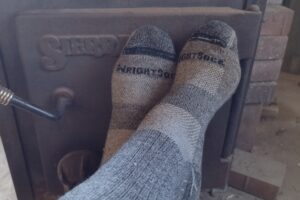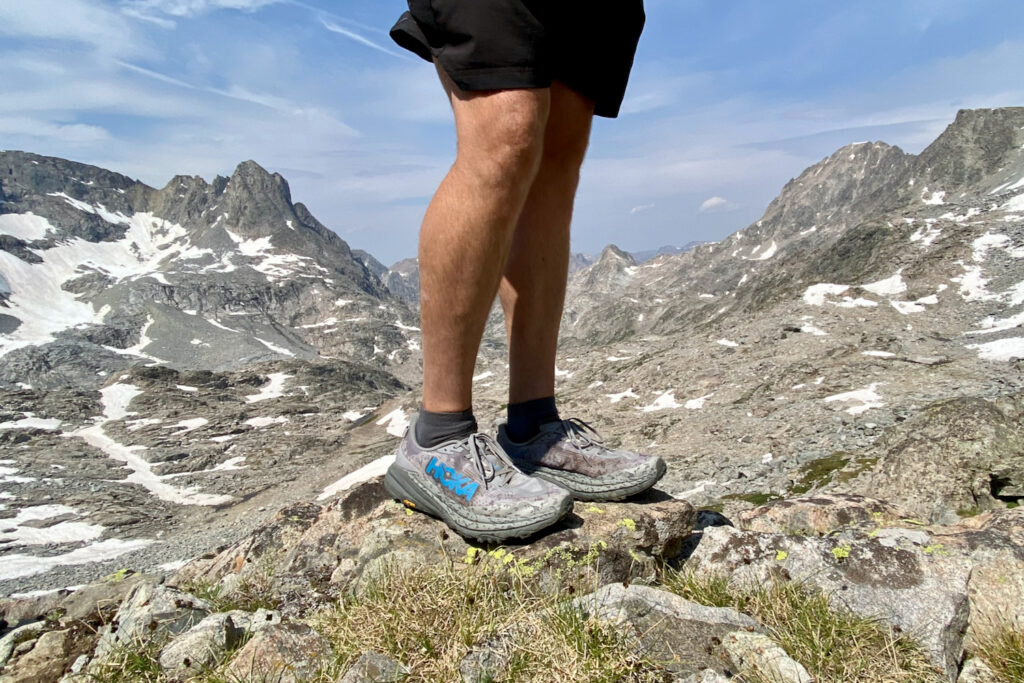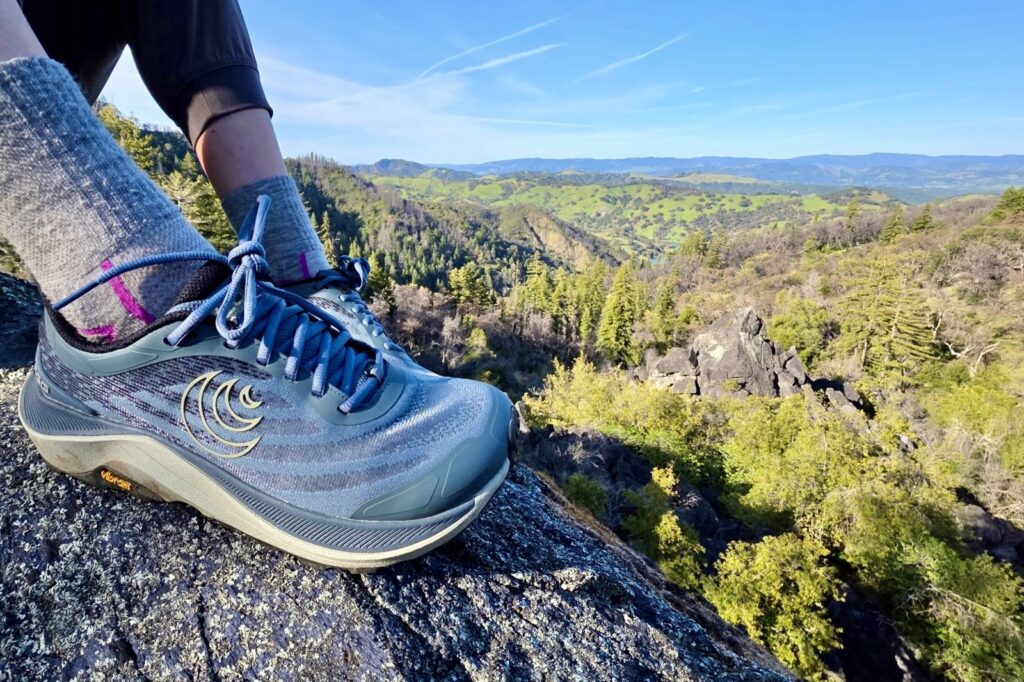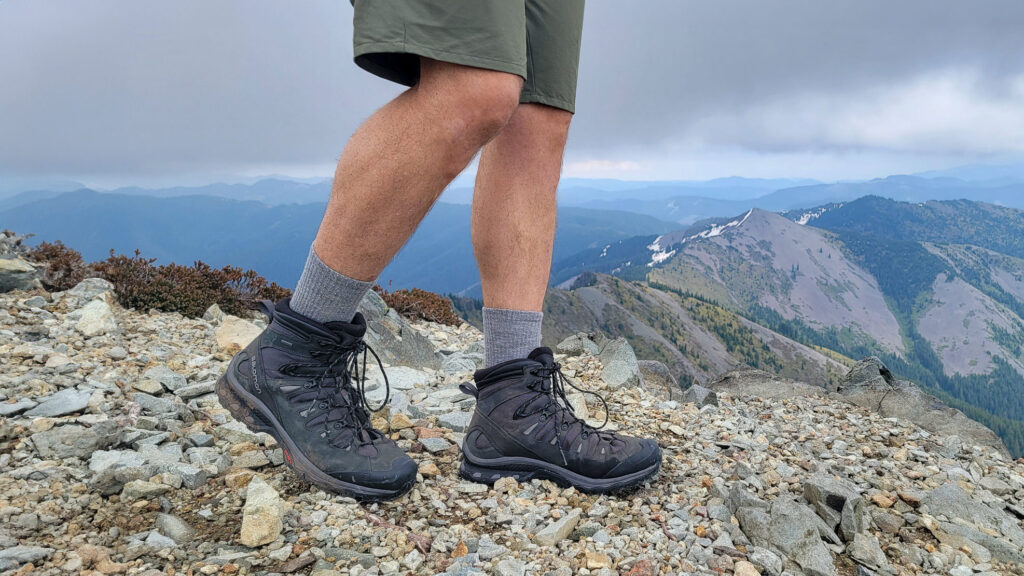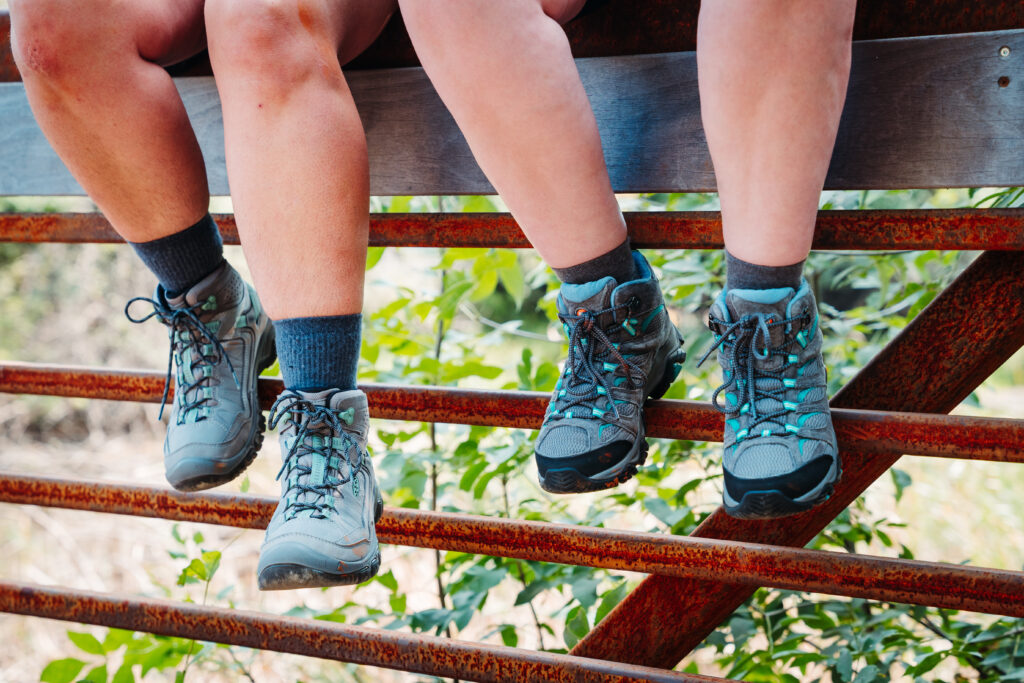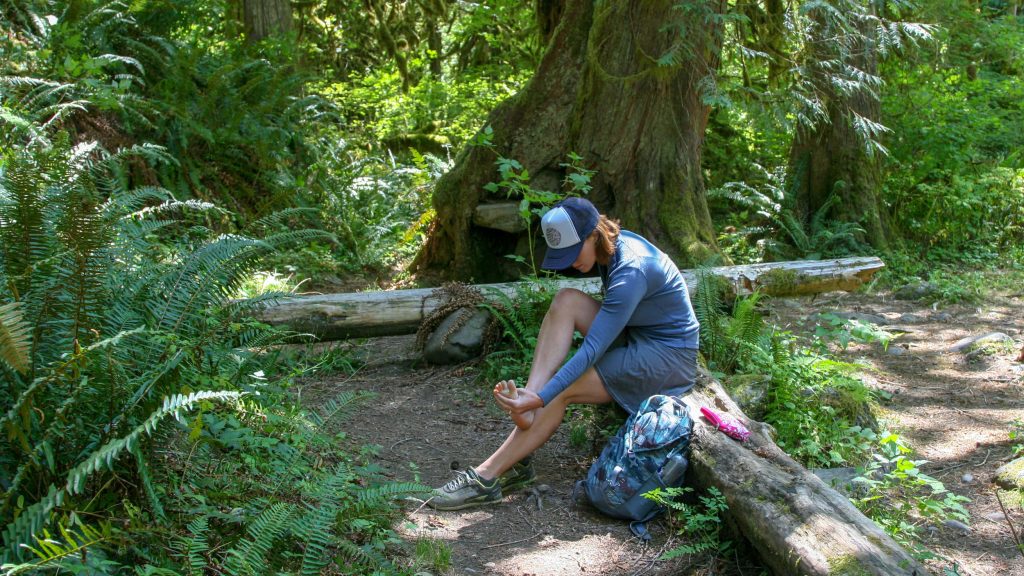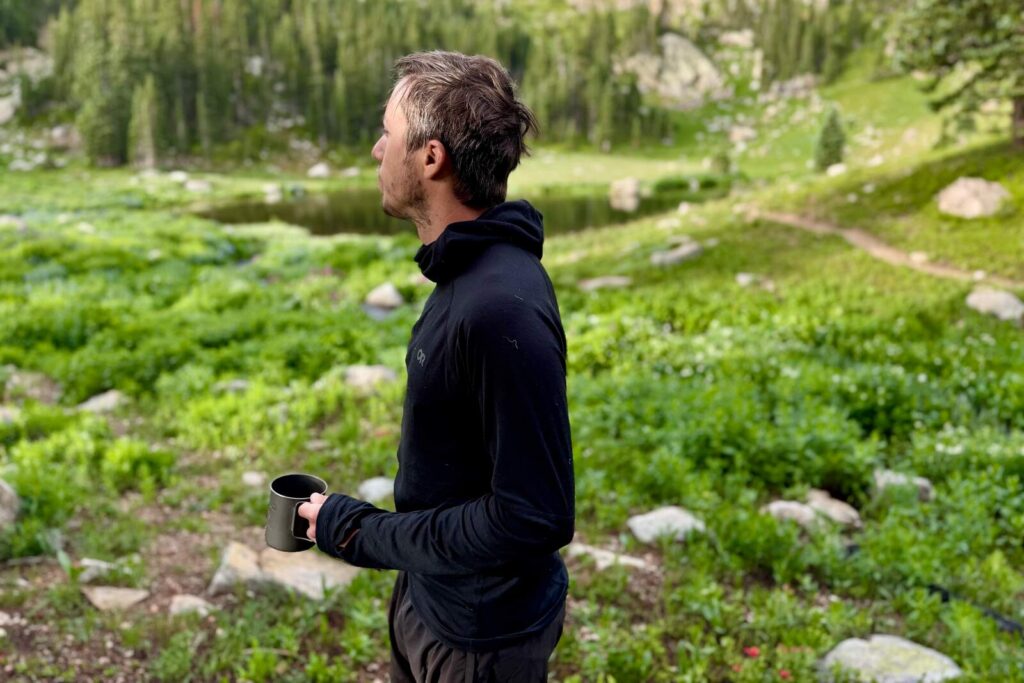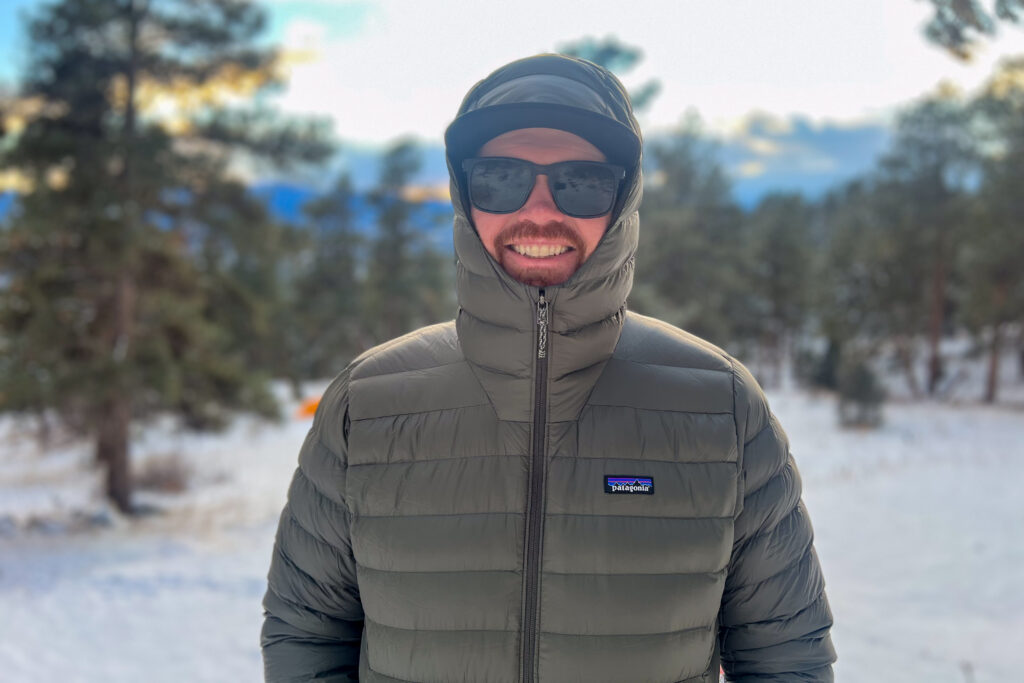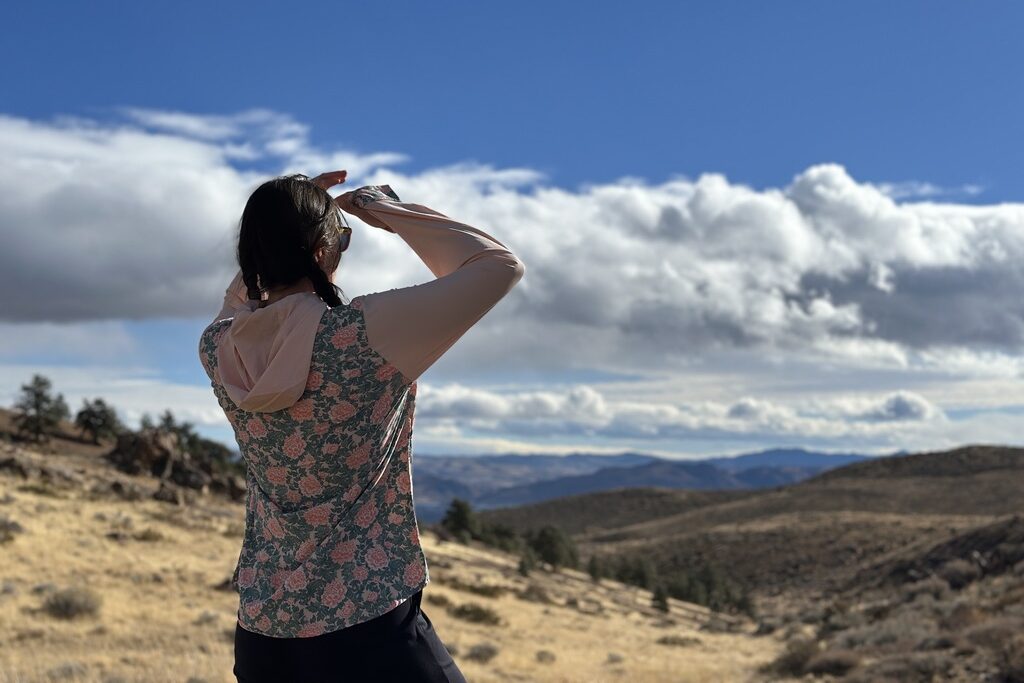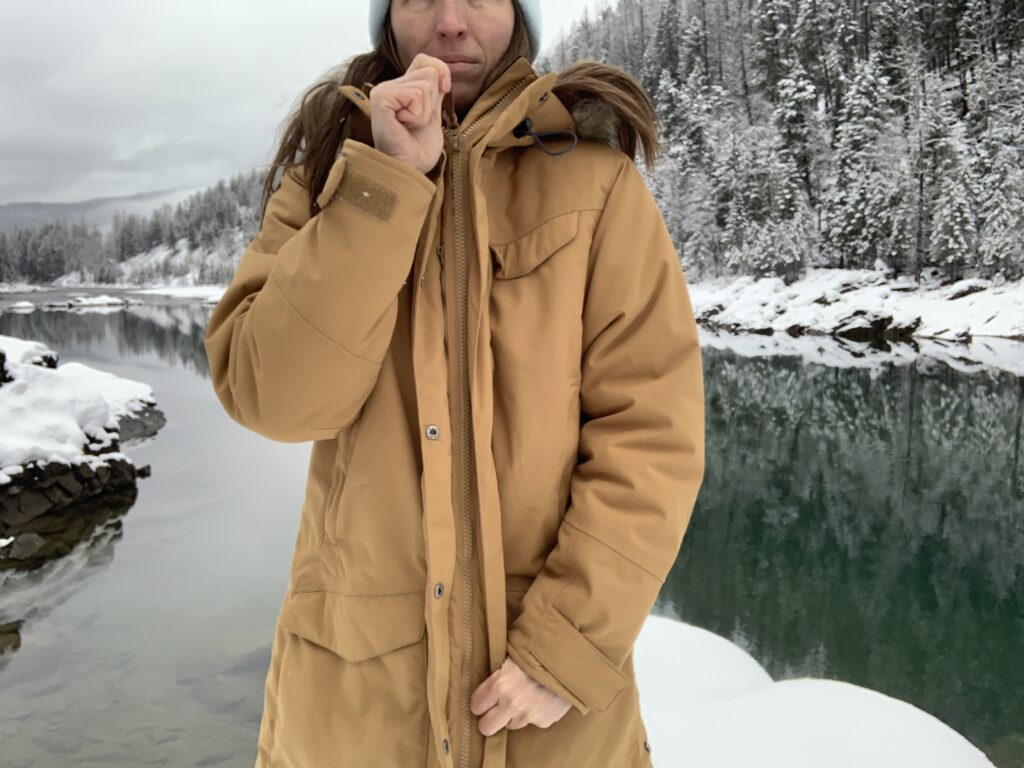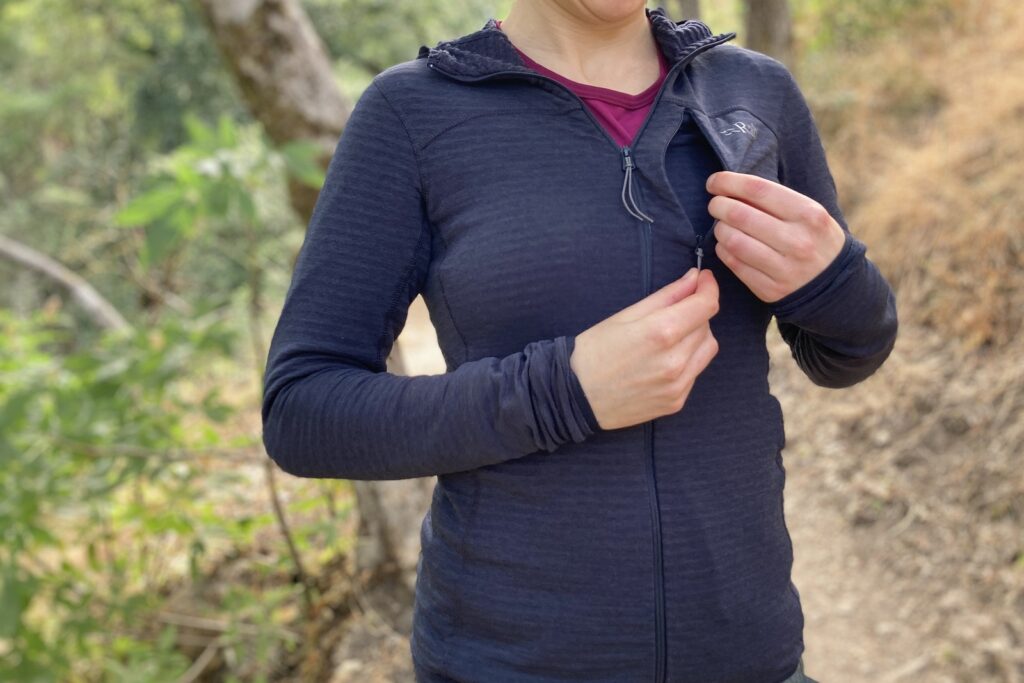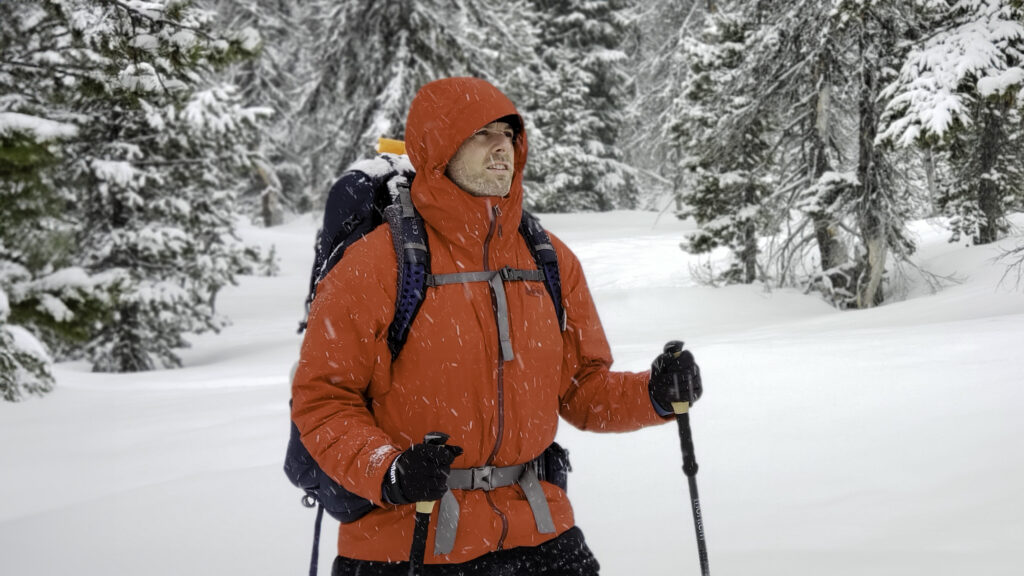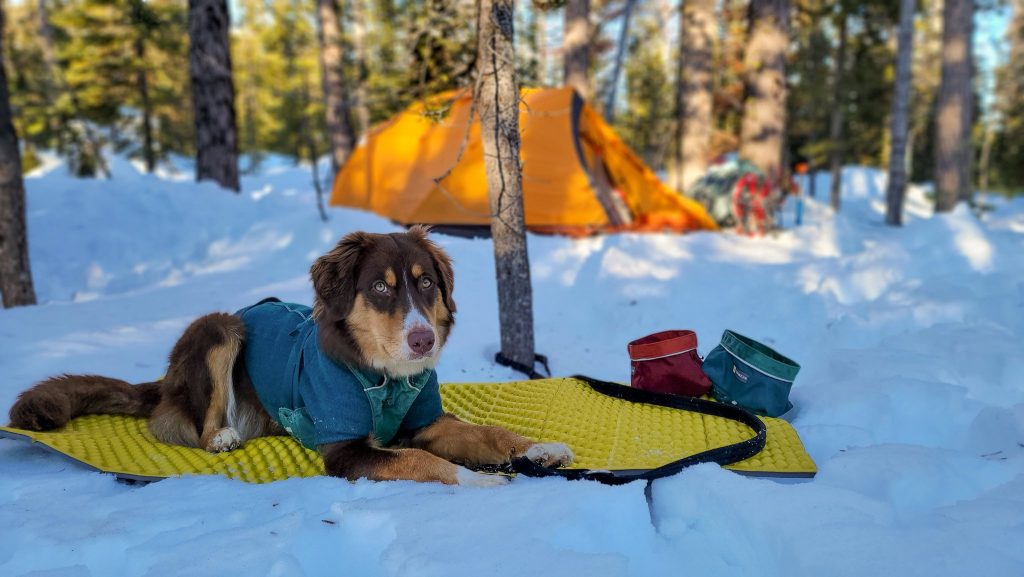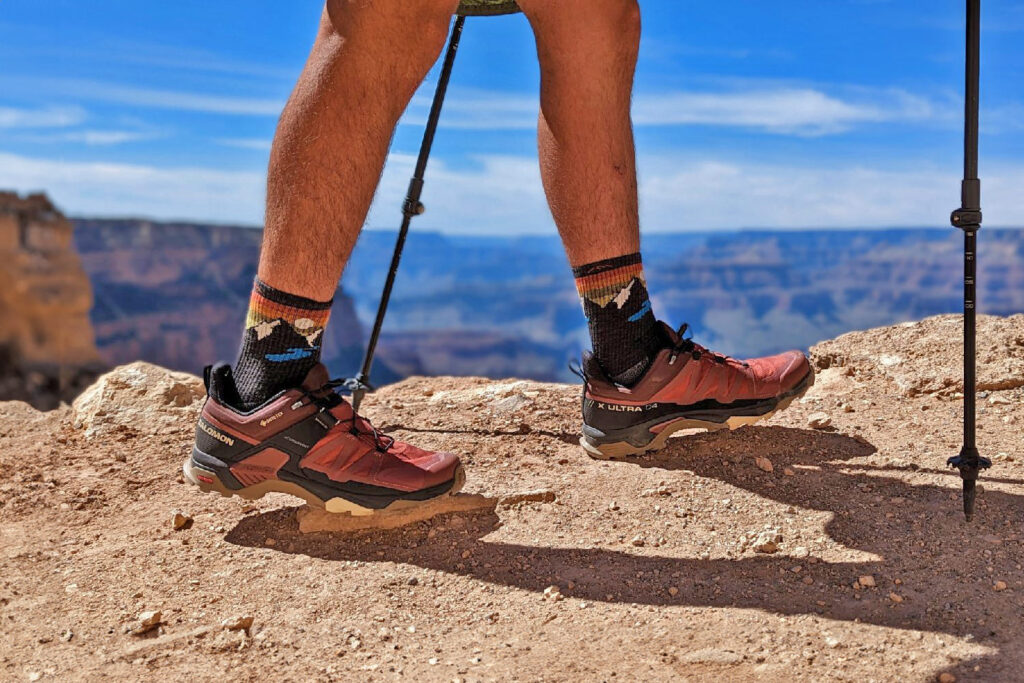
Quality socks make a big difference in keeping your feet comfortable and in good shape on trail. Our team has rigorously tested over 50 pairs of socks on hikes, trail runs, and backpacking trips all over the world to find the best ones for any adventure.
We’ve assessed pairs from Darn Tough, Smartwool, Balega, Feetures, and more based on comfort, warmth, durability, and breathability and dry time. We put every pair of socks through their paces, from dusty desert routes to muddy, misty, high alpine trails.
And for more info, check out some of our other popular gear guides:
Quick Picks for Hiking Socks
Get a leg up on the best hiking socks with this quick list, or kick back and scroll down to see our in-depth reviews.
Best Hiking Socks Overall: Darn Tough Light Hiker Micro Crew Men’s ($25) / Women’s ($25)
Best Full-Cushion Hiking Socks: Darn Tough Hiker Full Cushion – Men’s ($30) / Women’s ($30)
Best Wool Socks with a Performance Fit: Smartwool Performance Hike Light – Men’s ($25) / Women’s ($25)
Best Value Wool Socks: REI Merino Hiking Crew – Unisex ($19)
Best Anti-Blister Socks: WrightSock Double Layer Silver Escape Crew ($27)
Best Durable & Warm Socks for Cold Weather: Darn Tough Mountaineering – Men’s (35$) / Women’s ($35)
Best Eco-Friendly Socks with Heavy Cushioning: Smartwool Hike Classic Edition Full Cushion Second Cut Crew ($23)
Best Budget No-Show Socks: Balega Hidden Comfort – Unisex ($16)
Best Cold-Weather Running Socks: Swiftwick Pursuit Quarter Crew High ($20)
Best No-Blister Ankle Socks: WrightSock Coolmesh II Socks – Unisex ($17)
Best Eco-Friendly Ankle Socks: REI COOLMAX EcoMade Lightweight Hiking Quarter Socks ($16)
Technical Socks For Hiking & Trail Running: Swiftwick Flite XT Trail – Unisex ($27)
Best Compression Socks: Sockwell Circulator – Men’s ($33) / Women’s ($33)
Best Thick & Warm Mountaineering Sock: Smartwool Classic Mountaineer Maximum Cushion Crew ($27)
Great All-Around Budget Hiking Sock: Minus33 Mountain Heritage Full Cushion Crew ($19)
Best Durable Socks Designed for Long Backpacking Trips: Farm to Feet Damascus – Unisex ($22)
Warm Merino Wool Socks: REI Merino Wool Expedition Crew ($23)
Best Toe Socks for Hiking: Injinji Trail Midweight Mini Crews – Men’s ($16) / Women’s ($16)
Best Socks for Aerobic Activity in Warm Conditions: Feetures Elite Light Cushion Quarter Socks – Unisex ($18)
Best Hiking Socks for Wet Conditions: Icebreaker Merino Hike+ Light Crew Men’s ($23) / Women’s ($17)
Best Sock Liner for Hiking: Fox River Wick Dry Alturas Liner ($11)
Budget-Friendly Merino Hiking Socks: Danish Endurance Unisex Merino 3-Pack – Unisex ($34)
Ergonomic Hiking Socks: FITS Socks Medium Crew ($27)
Solid Hiking Sock Liners You Can Wear on Their Own: Minus33 Mountain Heritage Micro Liner ($19)
What’s new
We’ve been testing a ton of new socks on trail against some of our all-time favorites, and this list has seen some big updates:
- The budget-friendly REI Merino Hiking Crew socks make our list thanks to their burly construction and comfortable, snug fit.
- The Darn Tough Mountaineering socks (men’s) / (women’s) earn a spot as warm and durable socks for hiking and trekking.
- The Darn Tough Hiker Full Cushions (men’s) / (women’s) make the list as cozy and warm full cushion socks for hiking.
- The Danish Endurance Unisex Merino 3-Pack makes the cut as the best bang for your buck for minimalist, lightweight merino socks.
Hiking Socks Overall Testing Scores
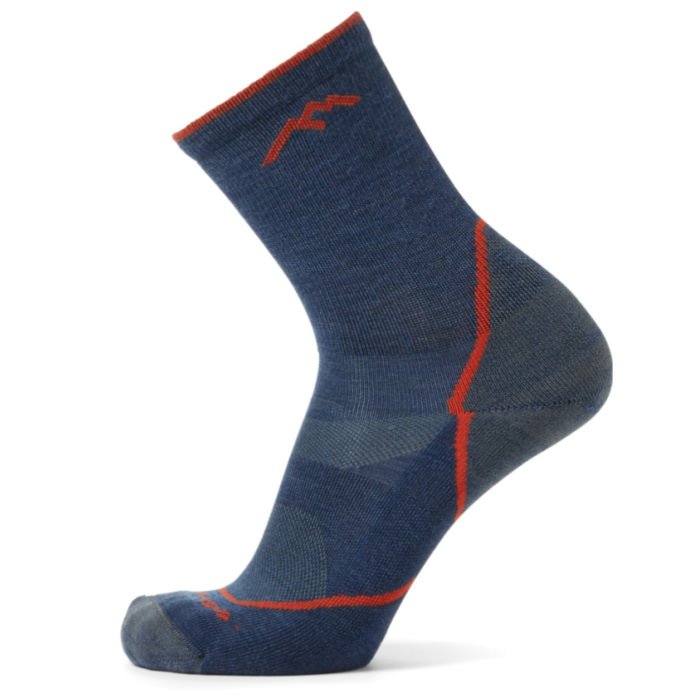
Darn Tough Light Hiker Micro Crew
Best Hiking Socks Overall
CleverHiker Rating: 5.0/5.0
Price: $25
Fabric: 54% nylon, 43% merino wool, 3% Lycra spandex
Height: Crew
Cushioning: Light
Pros
- Durable
- Breathable
- Moisture-wicking
- Odor-resistant
- Comfortable
- Don’t slide down
Cons
- Less padding than others
- Warmer/less breathable than some
Darn Tough Light Hiker Micro Crews (men’s / women’s) are our number one pick for hiking socks: they’re comfortable, versatile, and built to last. If you’re looking for a stellar all-around sock for everything from day hikes and weekend backpacking trips to the longest thru-hikes in the world, the Hiker Micro Crews are our top choice.
These are the preferred hiking socks of CleverHiker Managing Editor, Ben Applebaum-Bauch. He’s hiked thousands of miles along the PCT, CDT, and several other long trails in the Light Micro Crews and they’ve never let him down. These socks are built to withstand the toughest conditions for months on end.
For hiking, they cover all the bases. Featuring low-profile seams, awesomely odor-resistant materials, and a snug fit that doesn’t slide down, this pair is a perfect fit.
The Light Micro Crews are comfortable from first try thanks to their very tight weave, which also gives them stellar durability. Though they’re a bit warmer and thicker than minimalist options on this list, we find these socks are still extremely breathable.
Darn Tough socks are a bit expensive but well worth the money since they last trip after trip and are backed up by an unconditional lifetime guarantee.
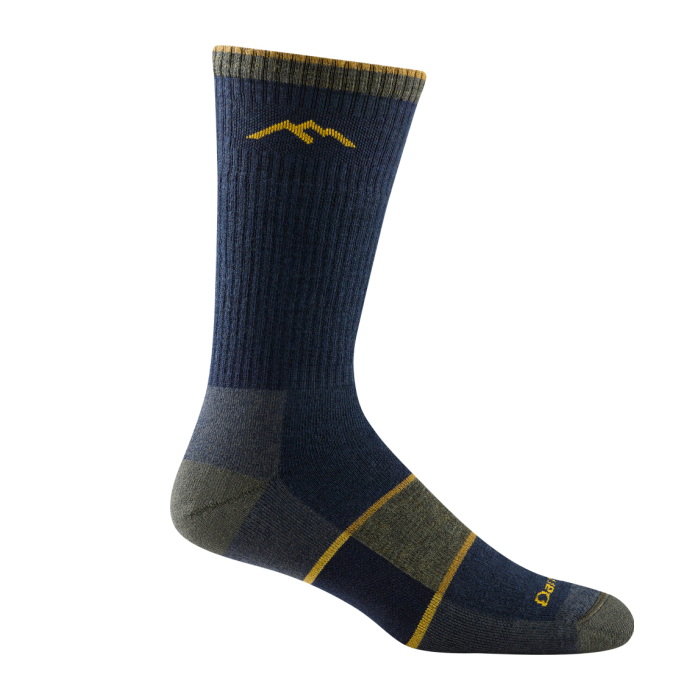
Darn Tough Hiker Full Cushion
Best Full-Cushion Hiking Socks
CleverHiker Rating: 5.0/5.0
Price: $30
Fabric: 69% merino wool, 27% Nylon, 4% Lycra Spandex
Height: Calf
Cushioning: Full
Pros
- Comfortable
- Excellent construction
- Warm
- Soft fabric blend
- Thick cushioning
- Versatile for year-round use
Cons
- Expensive
- A bit bulky & thick
- Too warm for hot days
- Dry slowly once wet
- Less breathable than others
If you want a full-cushion hiking sock to keep you warm on cool weather adventures, look no further than the Darn Tough Hiker Full Cushion socks (men’s / women’s). These are warm, comfy, and cushy socks built for year-round use, from skiing and backpacking to day trips and travel.
CleverHiker Managing Editor, Ben Applebaum-Bauch, has taken the Hiker Full Cushions on thousands of miles of trails including the Oregon Coast Trail and North Country Trail. He loves them as dual-purpose socks for cold weather hiking and bedtime. Gear Analyst, Ian Krammer, also used the Full Cushions while hiking 25 Colorado 14ers and they kept him warm and blister-free on windy, cold alpine ridgelines.
The Hiker Full Cushions are strong, thick, and stylish socks built to last (some pairs have lasted us three or more seasons!). They’re versatile as an extra layer anytime the mercury dips during winter hikes, and are a great choice for staying warm around the fire, in our sleeping bags, or running errands on overcast days at home.
These are thick, full-cushion socks, so they’re a bit bulkier than others on this list, and they’re one of our last picks for hot summer hikes. That said, we always keep a pair of the Hiker Full Cushions around – they’re so comfy, snug, and durable, you’ll be reaching for them for years.
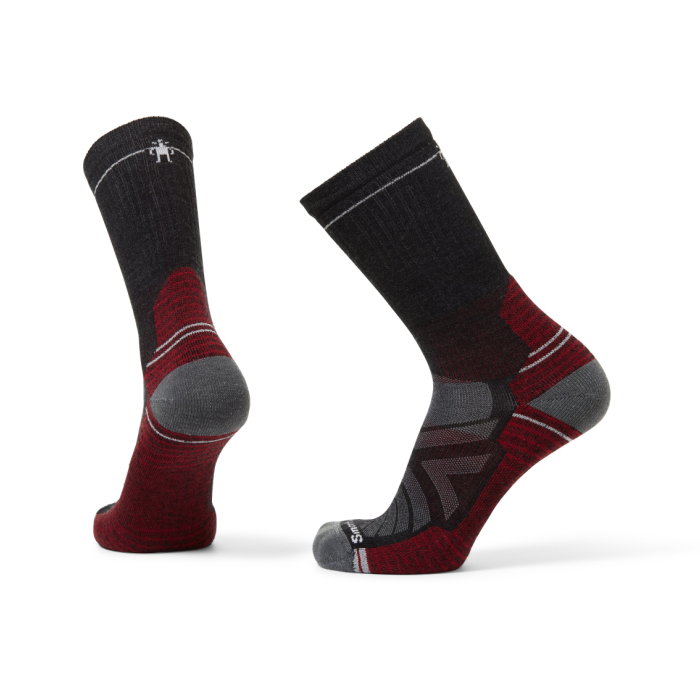
Smartwool Performance Hike Light
Best Wool Socks with a Performance Fit
CleverHiker Rating: 4.9/5.0
Price: $25
Fabric: 56% merino wool, 41% nylon, 3% elastane
Height: Crew
Cushioning: Light
Pros
- Comfortable
- Breathable
- Moisture-wicking
- Odor-resistant
- Don't slide down
- Lightweight
- Durable materials
Cons
- Less padding than others
- Not as stretchy as some
Smartwool’s Performance Hike Light (men’s / women’s) socks have been at the top of our list for years. The Hike Lights offer a snug, anatomical fit with reinforced padding where you need it, and durable materials that breathe well.
The Hike Lights check every box we want in quality hiking socks. Like their name implies, this pair is lightweight and breathable, making them a great choice from fall until spring. And, even after long, hot days on trail, we’re impressed with how little they smell after they dry out.
We love durable socks, and the Hike Lights stand out thanks to the tough wool in the heel and toe, which substantially extends their lifespan. While these Smartwools aren’t quite as strong or long-lasting as the Darn Tough Micro Crews, they’re very close. Plus, if you wear them out and return them within two years, Smartwool will replace them.
The Hike Lights are a bit spendy, but they represent an awesome value and some of the highest quality hiking socks on this list. For those who prefer an option that’s a bit lighter and more breathable than Darn Toughs, this is a great alternative.
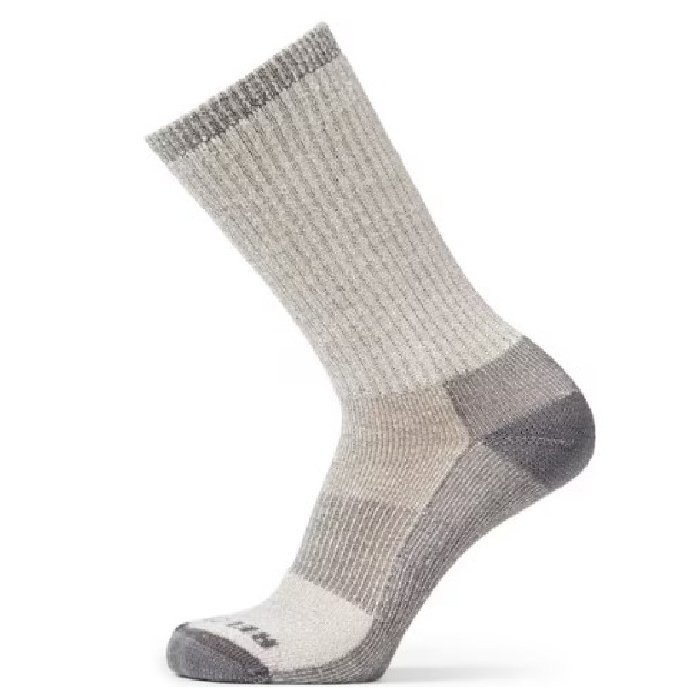
REI Merino Hiking Crew
Best Value Wool Socks
CleverHiker Rating: 4.9/5.0
Price: $19
Fabric: 79% merino wool, 20% nylon, 1% Lycra spandex
Height: Crew
Cushioning: Light
Pros
- Good value
- Comfortable
- Breathable
- Moisture-wicking
- Odor-resistant
- Warm
- Durable materials
Cons
- Too warm for summer conditions
- Can slide down with low footwear
The REI Merino Hiking Crew Socks are comfy, warm, and an excellent value for outdoor adventures. They’re made with top-quality wool but cost less than those from other top brands.
The Hiking Crews have a great balance of padding and breathability, which makes them a cozy and versatile choice for long days on the trail, or for wearing as sleep socks on camping and backpacking trips. When temperatures are 55°F and below, the Hiking Crews are one of our go-to pairs.
Our only complaints about this REI model is typical of heavier wool socks: they’re hot for summer conditions, so if you’re spending time in soaring July temperatures, you’ll want to find a lighter option. We’ve found the Hiking Crews stretch out a bit over time, which means they can slide down when worn with low-cut shoes after a dozen uses.
But, neither of these issues are dealbreakers – these are a step ahead of the competition for merino wool. If you’re looking for a comfortable hiking sock without breaking the bank, you can’t go wrong with the Hiking Crews.
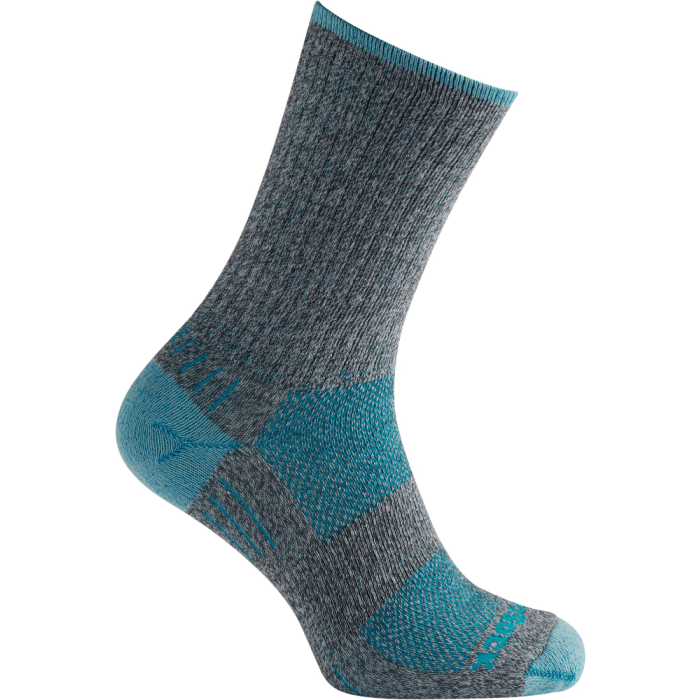
WrightSock Double Layer Silver Escape Crew
Best Anti-Blister Socks
CleverHiker Rating: 4.8/5.0
Price: $27
Fabric: 68% Recycled Polyester, 24% Nylon, 8% Lycra
Height: Crew
Cushioning: Light
Pros
- Built-in liner guards against blisters
- Not itchy
- Good wicking
- Dries quickly
- Comfortable
Cons
- Higher price tag
- Can feel tight
The Wrightsock Silver Escape crew socks take a unique approach to blister prevention with their double-layer system, and they actually deliver on the promise. The silver-infused inner layer genuinely keeps odor at bay even after multiple days of use, making these a standout choice for extended trips.
The medium cushioning hits a nice balance between protection and bulk, while the mesh panels keep things surprisingly breathable despite the double-layer construction. The stabilizer zone does its job well, preventing the annoying sock slip that can lead to blisters.
However, the synthetic construction (while great for quick drying) doesn’t offer the same temperature regulation as Merino wool options. The outer layer can start showing wear before the inner layer, though the overall durability is solid. They’re also a bit pricier than single-layer synthetic socks.
If you’re blister-prone or particularly concerned about foot odor, these socks are worth every penny. The double-layer system and silver technology work as advertised; just don’t expect merino-level temperature regulation for cold weather hiking.
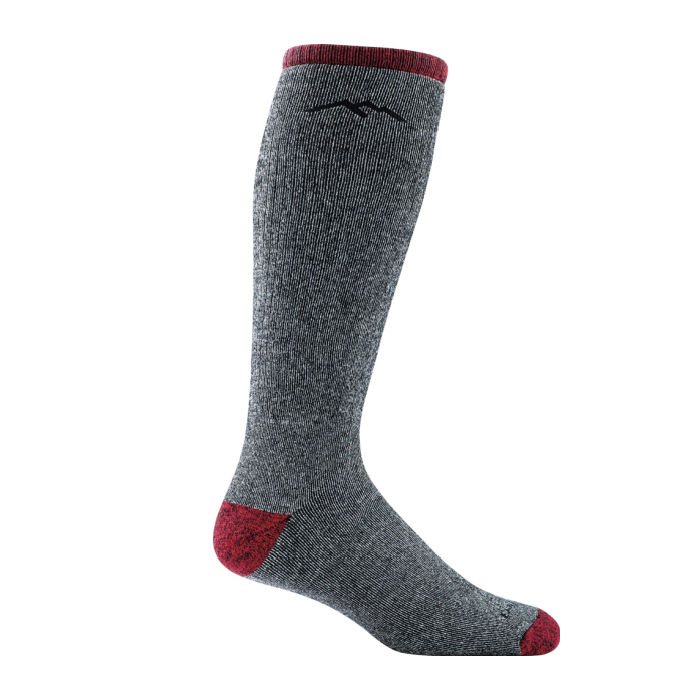
Darn Tough Mountaineering Socks
Best Durable & Warm Socks for Cold Weather
CleverHiker Rating: 4.7/5.0
Price: $35
Fabric: 72% merino wool, 26% nylon, 2% spandex
Height: Knee
Cushioning: Full
Pros
- Affordable
- Lifetime warranty
- Comfortable
- Moisture-wicking
- Breathable
- Don't slide down
- Smooth-feeling fabric
Cons
- Hold odor more than others
- Lack long-term durability
If your adventures involve romping deep in the mountains, off trail, and in cold temperatures, the Darn Tough Mountaineering Socks (men’s / women’s) are the burly backcountry socks of your dreams. They are ultra-durable, extremely cushy, and warm enough to handle the best – and worst – alpine conditions.
Gear Analyst, Ian Krammer, summited more than 500 Colorado peaks over 13,000’ in the Mountaineering Socks. With hundreds of days and nights in this model, Ian finds they are warm, comfortable, and durable enough to handle hundreds of rough miles year-round. From backcountry snowshoeing to summer bushwhacking to frigid nights camped near alpine lakes, these socks are built for the biggest adventures.
The Mountaineering Socks’ cushioning is one of the softest and comfiest options on the market. The fabric blend is merino wool with a durable but stretchy nylon, making them easy to put on and take off. They extend almost to the knee, perfect for use with tall hiking and mountaineering boots. But, they’re breathable up to 60°F, great for long days in the high country where temps can swing from warm to cold in the blink of an eye.
The Mountaineering Socks are bulky and thick compared to most socks on this list, making them a poor choice for low-elevation adventures, humid summer hikes, and water crossings. Also, due to the sheer amount of wool, the Mountaineering Socks are also one of the most expensive options we’ve reviewed.
However, they are a long-term investment in top-tier durability and warmth. If you want to keep your toes warm at altitude, this Darn Tough model will last many years and withstand hundreds of miles of rough use.
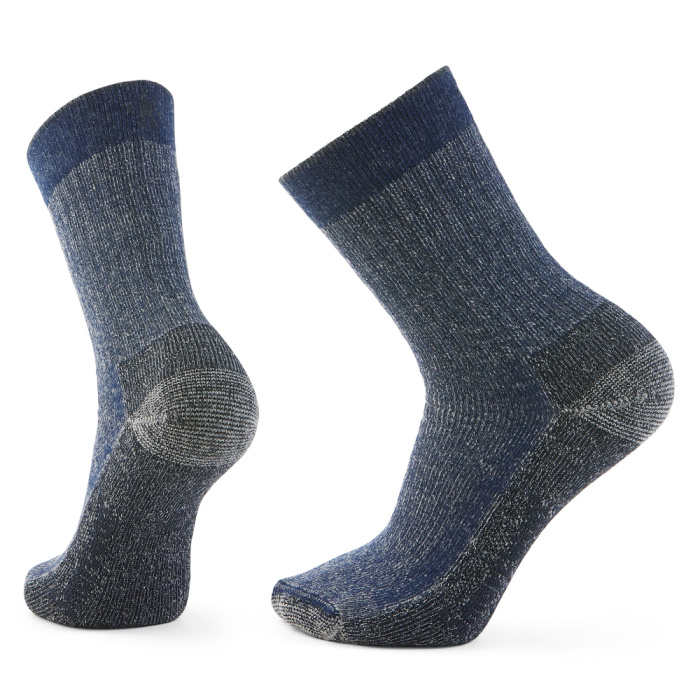
Smartwool Hike Classic Edition Full Cushion Second Cut Crew
Best Eco-Friendly Socks with Heavy Cushioning
CleverHiker Rating: 4.7/5.0
Price: $23
Fabric: 33% merino wool, 33% other fiber, 24% recycled nylon, 9% nylon, 1% elastane
Height: Crew
Cushioning: Heavy
Pros
- Partially made with recycled content
- Great odor control
- All-day comfort
- Quick dry
Cons
- Wool can be scratcy to some
- Less durable
The Smartwool Hike Classic Edition Second Cut socks are partially made from old recycled socks given new life through Smartwool’s take-back program. This pair has reliable performance with a comfortable fit and solid moisture management.
The elasticized arch and flat-knit toe seams deliver the comfort you’d expect from a premium hiking sock, while the eco-friendly construction helps reduce the environmental impact of discarded socks. It’s a win-win sock situation.
However, they’re not quite as durable as the original Classic Hike. Though they might not be the most bombproof socks in your drawer, they’re solid performers that make something old new again.
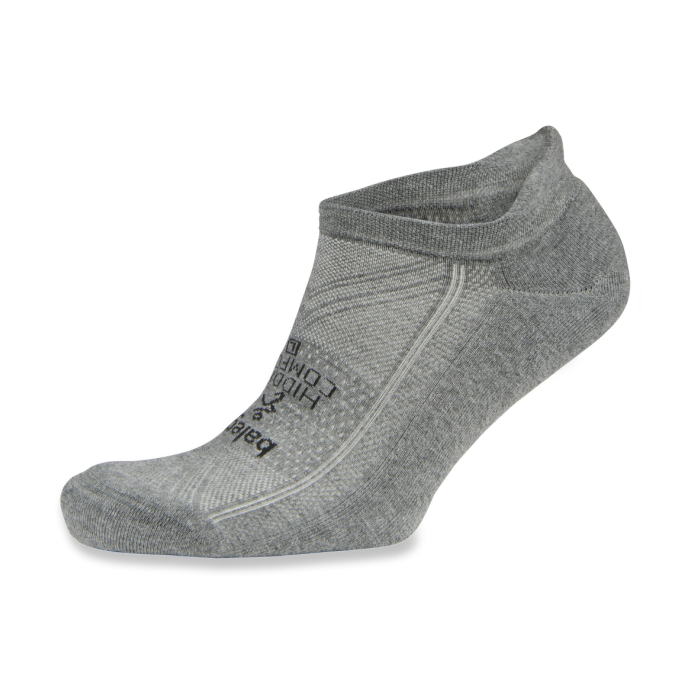
Balega Hidden Comfort
Best Budget No-Show Socks
CleverHiker Rating: 4.7/5.0
Price: $16
Fabric: 100% polyester
Height: No Show
Cushioning: Medium
Pros
- Affordable
- Comfortable
- Don't slide down
- Moisture-wicking
- Breathable
Cons
- Not as durable as some
- Ankle tabs aren't for everyone
Balega’s Hidden Comfort Socks are simple, lightly padded, and some of the most breathable socks we’ve tested. We’re big fans of the cushy ankle tabs that prevent them from bunching up or sliding down while you’re hiking, running, and walking.
The Hidden Comforts are an all-time favorite of Dave Collins, founder of CleverHiker. He’s used these for over seven years of warm-season day hikes and thru-hikes in places like the JMT, Yosemite, the Sawtooths in Idaho, and Banff. These are Dave’s top recommendation for breathable, lightweight socks to pair with trail runners.
The Hidden Comforts are as airy as socks get. Even though they’re 100% polyester, we love how well they breathe, keeping our feet cool and dry on strenuous summer hikes. If you want a synthetic fabric, the low cut and awesome ventilation of the Hidden Comforts will be a game changer.
The downside of polyester is that it doesn’t last as long as other fibers like nylon or wool blends, so we advise picking up several pairs to get you through a full season of hiking. Also, the very low cut and unique ankle tabs won’t suit everyone’s preferences.
The Hidden Comforts are an excellent, affordable choice as comfortable, low-cut socks for everyday use. Whether you’re repeating your favorite local trail or trekking deep into the backcountry, this Balega model is worth considering.
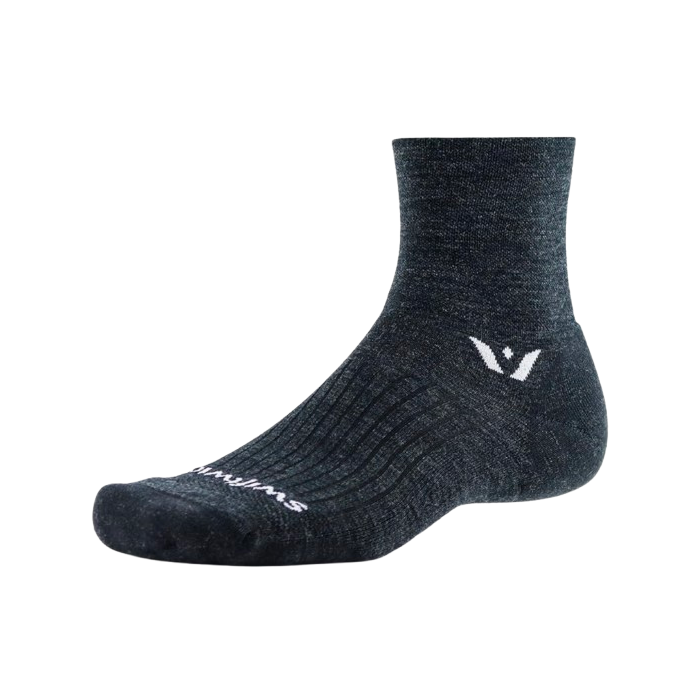
Swiftwick Pursuit Quarter Crew High
Best Cold-Weather Running Sock
CleverHiker Rating: 4.6/5.0
Price: $20
Fabric: 62% merino wool, 35% nylon, 3% Spandex
Height: Crew
Cushioning: Light
Pros
- Durable
- Comfortably snug fit
- No-blister guarantee
- Hold their shape
- Ideal for trail running
Cons
- Compressed fit not ideal for all
- Not warm enough for colder weather
The Swiftwick Pursuit Quarter Crew High is a standout performer, bringing something unique to the Merino sock game. Unlike bulkier competitors, these socks nail the balance between warmth and profile – keeping your feet warm enough in cold weather without making your footwear feel cramped. The moderate compression hits just right—snug enough to prevent sliding but not so tight that you feel restricted.
The Merino blend is noticeably lighter than other brands, which is fantastic for maintaining shoe fit and comfort during winter runs or nordic skiing sessions. However, the thinner construction might raise some durability concerns compared to beefier options.
The downside? We found they aren’t great for warm weather; our feet got pretty toasty above freezing. And while the thin construction is a plus for fit, it might impact long-term durability compared to thicker options. Perfect for winter running and nordic skiing when you want warmth without bulk.
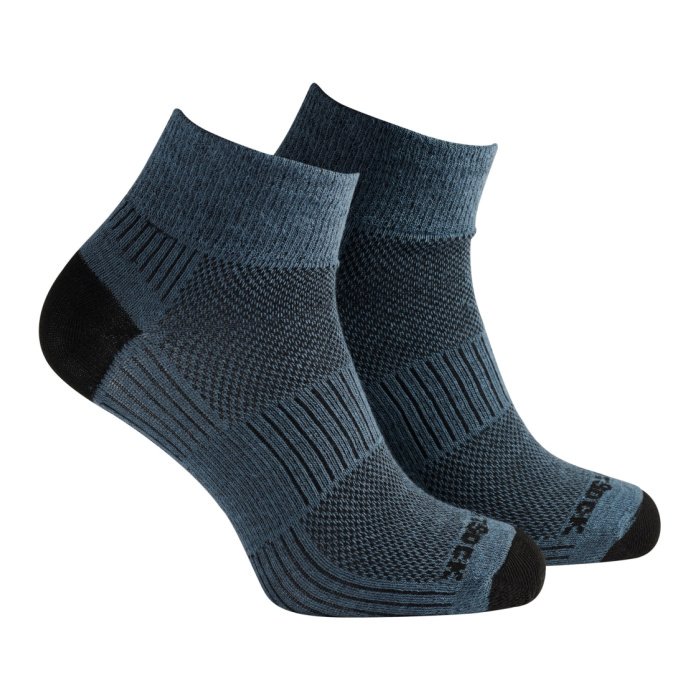
WrightSock Coolmesh II
Best No-Blister Ankle Socks
CleverHiker Rating: 4.6/5.0
Price: $17
Fabric: 70% Dri-Wright II polyester, 26% nylon, 4% lycra
Height: Ankle
Cushioning: Light
Pros
- Helps prevent blisters
- Affordable
- Breathable
- Moisture-wicking
- Very comfortable
- Lifetime warranty
- Don't slide down
Cons
- Not as durable as some
- Hold odor more than others
If comfort and breathability are your top priorities, the WrightSock Coolmesh II Socks are a great choice: they feel like breathable slippers on your feet. This is one of our favorite socks for day hikes and short backpacking trips. They’re minimal, cover your ankles, and the double-layer system is excellent at preventing blisters.
In fact, the Coolmesh IIs are a great choice if you’re prone to hot spots. These socks offer another line of defense thanks to two layers of synthetic material, which reduces rubbing against the inside of your shoe, and effectively wicks away moisture.
We love these socks because the fabric blend is lightweight and luxurious. The result of an all-synthetic sock blend is a cool-feeling, instantly comfortable, and snug pair of socks that layer perfectly with your favorite pair of trail runners or hiking shoes.
However, the Coolmesh IIs are fairly thin, so they wear down quickly in the heel and toe areas – which is why we don’t recommend them for longer trips or thru-hikes. However, at such an affordable price, the Coolmesh IIs are one of the most budget-friendly pairs of socks we tested.
For those with blister-prone feet, we highly recommend keeping a few pairs of these socks handy. They make an excellent addition to your sock rotation for hot months, breaking in new shoes, and covering moderate miles – and you can always replace them as needed.
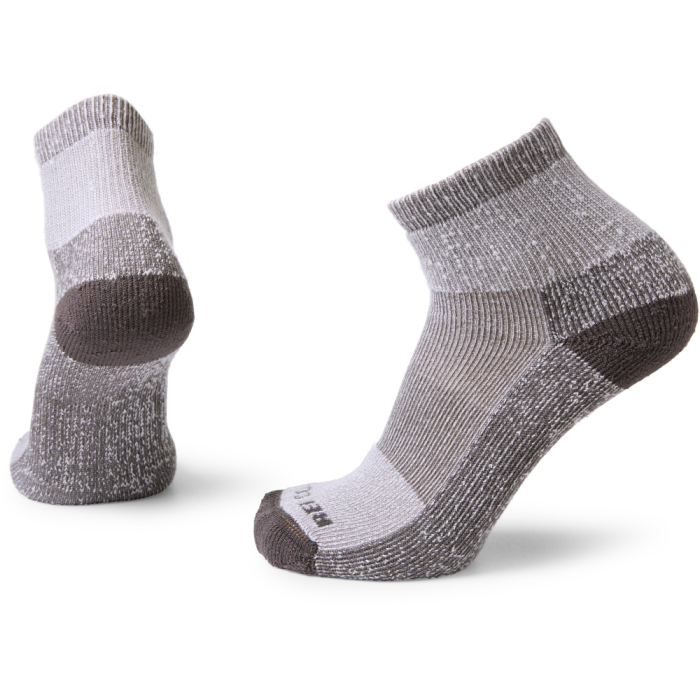
REI COOLMAX EcoMade Lightweight Hiking Quarter Socks
Best Eco-Friendly Ankle Socks
CleverHiker Rating: 4.6/5.0
Price: $16
Fabric: 77% recycled polyester, 22% nylon, 1% spandex
Height: Ankle
Cushioning: Light
Pros
- Versatile in hot & cold
- Comfortable
- Lightweight
- Cushioned heel
- Partially made from recycled material
Cons
- Susceptible to shrinking in wash
- Can develop holes quickly
- Holds odor more than others
The REI Coolmax EcoMade socks are a solid budget-friendly option made from recycled plastic bottles. For hot-weather hiking, these synthetic socks excel at moisture management, effectively wicking away sweat while providing decent cushioning and support.
The cushioning level works well for casual day hikes and everyday wear, and they dry quickly and maintain their shape better than wool options when wet.
The fit is where things get interesting. They’re comfortable but tend to loosen up over time, lacking the precise, locked-in feel of more premium options. Like most synthetic socks, they can’t escape the dreaded stink factor after extended use. While the sustainability DNA is great, they’re not quite built for the long haul like top-tier alternatives.
These socks are perfect for casual hikers and environmentally conscious folks who want capable, affordable hot-weather performance. Just keep some backup pairs handy for longer trips.
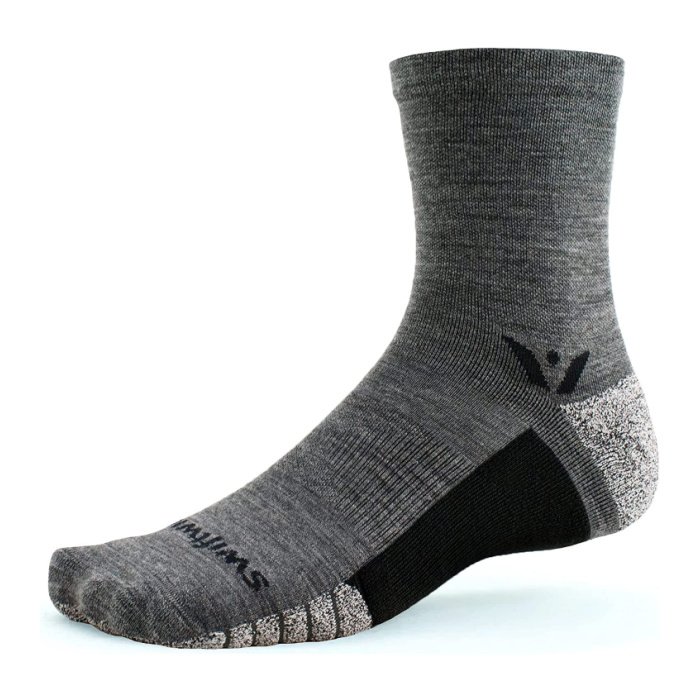
Swiftwick Flite XT Trail
Technical Socks for Hiking & Trail Running
Price: $27
Fabric: 38% nylon, 24% merino wool, 22% olefin, 13% polyester, 3% spandex
Height: Crew
Cushioning: Medium
Pros
- Comfortable
- Durable
- Moisture-wicking
- Breathable
- Odor-resistant
- Don't slide down
Cons
- Expensive
- Run a little big
Swiftwick’s Flite XT Trail are some of the first socks we search for in the drawer when packing for fast-moving adventures. They offer medium compression for additional tendon support, don’t slip down, and they’re so comfy you’ll barely notice them.
The XT Trails are the perfect weight for a wide range of temperatures – we’ve worn them on long-distance trips from 90°F days in the desert to frigid high mountain passes, and they held up with no issue. The combo of merino wool and synthetic fibers offers a great balance of thermoregulation and durability – plus, the material wicks moisture with ease, and dries fast when wet.
We love the soles of these socks, which include fibers that help grip the inside of your shoe to reduce slippage. That means less movement inside of your shoe to minimize hot spots, pain points, and blisters.
The Flite XTs are a little more expensive than others, and they tend to run a bit big in our experience, so we recommend trying them on before purchase. That said, this Swiftwick model is a versatile performer for three-season hiking and trail running, and lasts longer than most comparable thin socks.
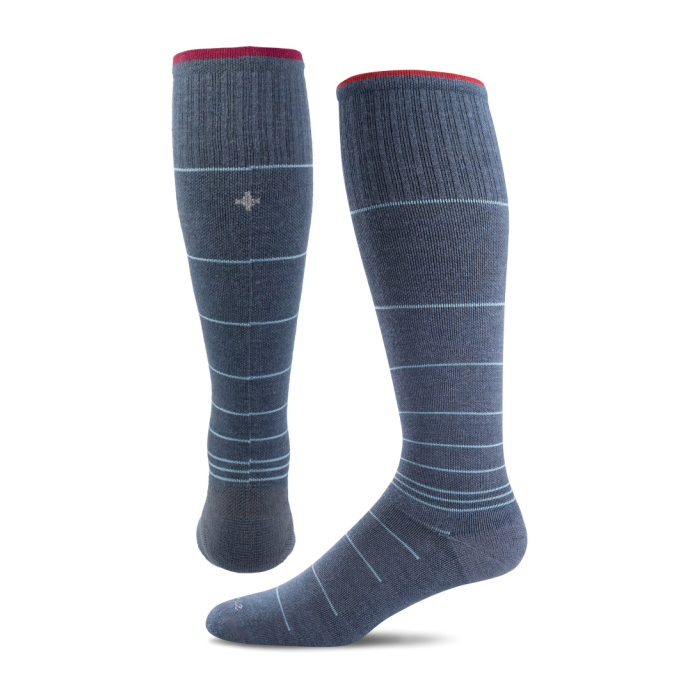
Sockwell Circulator Compression
Best Compression Socks
CleverHiker Rating: 4.5/5.0
Price: $33
Fabric: 32% merino wool, 32% stretch nylon, 31% rayon from bamboo, 5% spandex
Height: Knee
Cushioning: Light
Pros
- Comfortable
- Durable
- Moisture wicking
- Effective compression design
- Versatile for many activities
- Quality construction
- Snug fit with forgiving stretch
Cons
- Expensive
- On / off can be a bit challenging
- Tall sock height isn’t for everyone
The Sockwell Circulator (men’s / women’s) is one of our favorite compression socks. They gently apply pressure to your legs and feet, which can help improve blood circulation, enhance recovery, and minimize swelling.
Gear Analyst, Ian Krammer, used the Circulator socks exclusively while healing after a major foot injury in the mountains. He found they were essential to aid his recovery process, playing a key role in reducing swelling, foot and leg fatigue, and limiting overall muscle soreness.
This Sockwell model stands out as especially comfy, snug, and durable for long days on the trail. It fits tightly around the foot, ankle, and calf, but the fabric blend is stretchy enough that they feel flexible and breathable. The Circulator’s fabric blend is also impressively long-lasting. In our experience, these socks will last through many dozens of short hikes before needing to be replaced.
Our biggest complaint about the Circulators is their steep price tag. That said, these are exceptionally effective compression socks, and worth every penny. If you’re a trail runner, backpacker, long-distance hiker, or weekend warrior who wants to maximize their performance, these are a stellar value for long, tough miles.
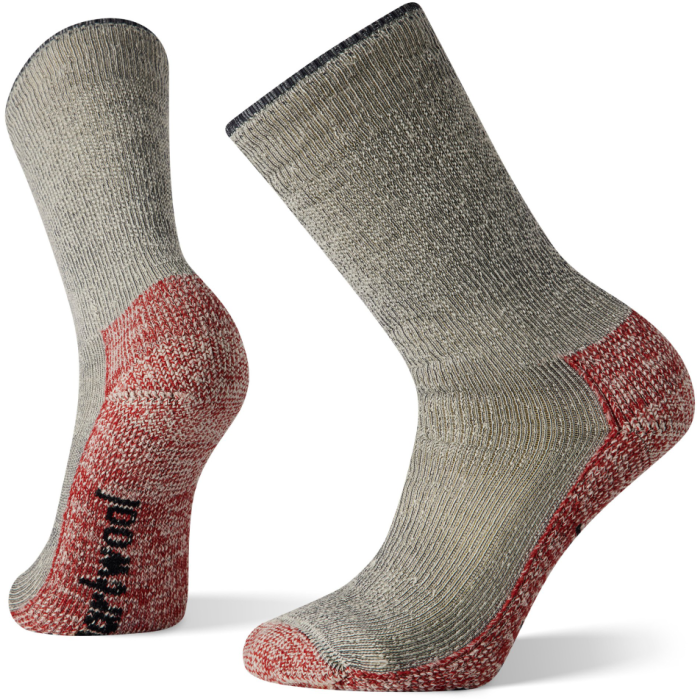
Smartwool Classic Mountaineer Maximum Cushion Crew
Best Thick & Warm Mountaineering Sock
CleverHiker Rating: 4.4/5.0
Price: $27
Fabric: 74% merino wool, 17% recycled nylon, 8% nylon, 1% elastane
Height: Crew
Cushioning: Heavy
Pros
- Durable
- Plush fit
- Very warm
- Odor-resistant
- Don't slide down
- Lightweight
- Durable materials
Cons
- Too much sock for casual users
- Long dry time
The Smartwool Classic Mountaineer socks have 74% Merino wool content and are like a cozy cabin for your feet in the coldest conditions. The cushioning is seriously plush. Whether you’re tackling snowy peaks or just trying to keep your toes from freezing in your sleeping bag, these socks deliver exceptional warmth and moisture management.
But they’re not without their quirks. The thick construction means they take their sweet time drying out, so you’ll want to pack extras for multi-day adventures. And while their warmth is a godsend in winter, it’s a major drawback in warmer weather.
If you’re heading into cold, wet conditions and want premium comfort and warmth, these socks are worth every penny. Just keep them in your winter rotation and have backup pairs for longer trips. They’re overkill for summer hiking, but they’re absolute champions when the mercury drops.
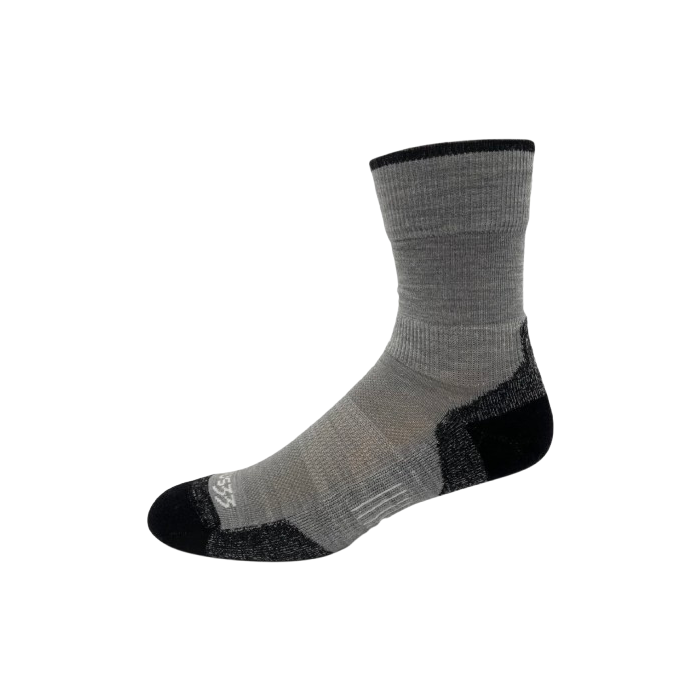
Minus33 Mountain Heritage Full Cushion Crew
Great All-Around Budget Hiking Sock
CleverHiker Rating: 4.4/5.0
Price: $19
Fabric: 60% merino wool, 25% nylon, 14% stretch nylon, 1% spandex
Height: Crew
Cushioning: Full
Pros
- Cushioned throughout for plush fit
- Regulates temps well
- Dries quickly
- Durable
Cons
- Can be too thick for some boots
- Tend to loosen around ankles
- Too warm for hotter temps
The Minus33 Mountain Heritage Full Cushion crew socks are a solid value performer. With 60% Merino wool content, they deliver impressive warmth and comfort at a price point that’s notably lower than premium brands. The full cushioning feels luxurious underfoot, making them particularly cozy for cold-weather hiking and everyday winter wear.
These socks really shine in their versatility. They’re equally at home on mountain trails or running errands around town. The understated design works well across multiple settings, and the build quality punches above its price range.
The Merino blend manages odor exceptionally well, so you can wear them multiple days on the trail without offending your tentmates. Temperature regulation is another strong point – your feet stay warm in cold conditions without overheating during active use. While not the most technical sock on the market, they handle moisture decently well for their thickness level.
While the full cushioning is comfortable, it contributes to slower drying times, a common issue with higher wool content socks. The cushioning can compress noticeably after several washes though, and the socks tend to slide down during longer hikes.
But if you’re looking for comfortable, warm, and versatile Merino wool socks at an affordable price point, these are a fantastic choice. They’re particularly well-suited for casual hikers, winter sports enthusiasts, and anyone who wants cozy feet without the premium price tag.
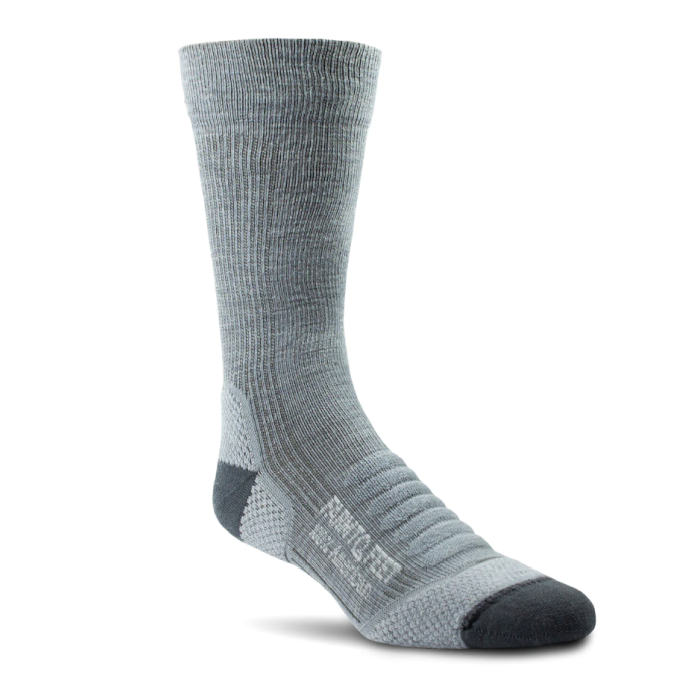
Farm to Feet Damascus
Best Durable Socks for Long Backpacking Trips
CleverHiker Rating: 4.4/5.0
Price: $22
Fabric: 51% merino wool, 45% nylon, 4% Lycra spandex
Height: Quarter
Cushioning: Light
Pros
- Durable
- Lifetime warranty
- Breathable
- Moisture-wicking
- Odor-resistant
- Comfortable
- Don't slide down
Cons
- Padding on top of foot can feel awkward
- Tight fit
The Farm to Feet Damascus socks are created with long-distance hikers in mind. Made in America, this pair is super breathable, doesn’t slip down, and will last for hundreds of miles.
The Damascus socks are impressively durable. Thanks to smooth stitching and top-tier materials, we’ve hiked 14+ hour days in these bad boys for weeks on end and found them just as comfortable, airy, and sturdy as day one. That said, if you do manage to wear them out, we love that they’re guaranteed for life.
Slight compression and unique targeted cushioning in the heel and toe keep the Damascus feeling comfy and light on all sorts of terrain and through long miles. A bit of extra cushioning on top of the instep also helps prevent pain from shoelace pressure, which is especially nice for long, steep descents.
The Damascus socks are tough to beat when it comes to solid construction and comfort. We recommend them for rugged hikes and backpacking trips in trail runners or hiking shoes when minimalist socks aren’t quite enough.
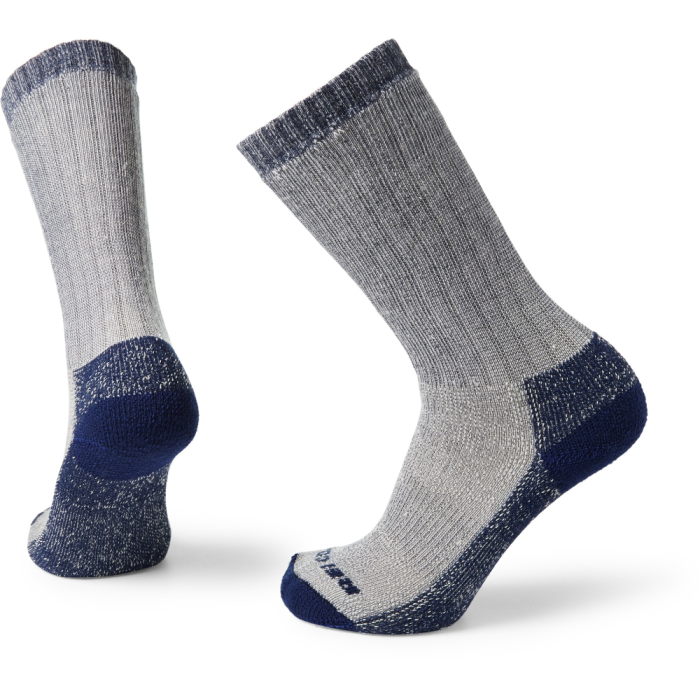
REI Merino Wool Expedition Crew
Warm Merino Wool Socks
CleverHiker Rating: 4.4/5.0
Price: $23
Fabric: 79% merino wool, 20% nylon, 1% lycra spandex
Height: Crew
Cushioning: Heavy
Pros
- Seamless toes
- Stretch arch
- Warm
- Reinforced areas
Cons
- Long dry time
- Inner material can be uncomfortable
The REI Merino Wool Expedition socks are built for cold-weather performance, boasting a hefty 79% merino wool content, among the highest you’ll find in hiking socks. This translates to excellent insulation and initial moisture management that’ll keep your feet comfortable during winter adventures.
However, when these socks get saturated, they lose their shape. Their thickness sits right on the border between lightweight and midweight so you’ll want to try them on with your actual boots to ensure they don’t cause any fit issues.
They’re not cheap, and the slow drying time means you’ll need extras if you’re planning extended adventures in wet conditions.
Overall, these socks are solid performers, with impressive wool content and ethical sourcing, for cold, relatively dry conditions. But consider alternatives if you’re expecting very wet conditions or prefer a snug boot. And budget for backup pairs – you’ll need them.
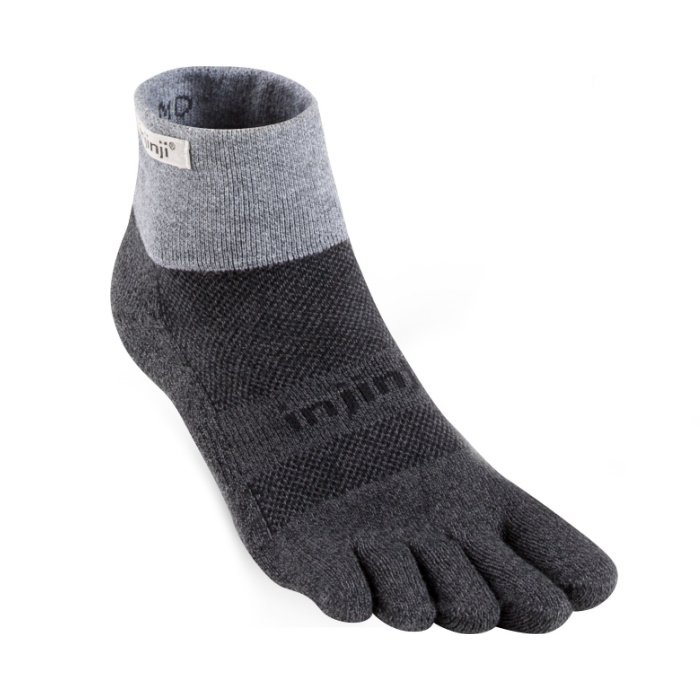
Injinji Trail Midweight Mini Crew
Best Toe Socks
CleverHiker Rating: 4.3/5.0
Price: $16
Fabric: 58% nylon, 39% CoolMax polyester, 3% lycra spandex
Height: Ankle
Cushioning: Medium
Pros
- Helps prevent toe blisters
- Affordable
- Comfortable
- Breathable
- Moisture-wicking
- Durable materials
Cons
- Hold odor more than others
- Takes a little longer to put on/take off
- Toe socks take getting used to
Injinji’s Trail Midweight Mini Crews (men’s / women’s) are some of the most popular toe socks on the market, and we’ve been using them for years. They’re affordable, comfy, highly breathable, and excellent for reducing friction between the toes for low-cut hiking shoes, trail runners, and sandals.
Since each toe is wrapped in wicking fabric, we find they do an exceptional job of keeping our feet dry on the trail and dramatically reducing the chance of hot spots, pain, and blisters. If you’re prone to sweaty feet and tend to do most of your hiking in the summer, the Mini Crews are an excellent choice for moisture management.
Toe socks may feel strange at first, especially since they take extra attention to put on and take off. We’ve also found these ones tend to hold smells a little more than others on this list, so you’ll want to hang them to dry outside of your tent or backpack.
But, if you frequently struggle with toe pain from rubbing or excess moisture, we think they’re worth learning to love. Plus, this Injinji model is a bit more durable than other toe socks we’ve tested, so they’ll keep you moving all season long.
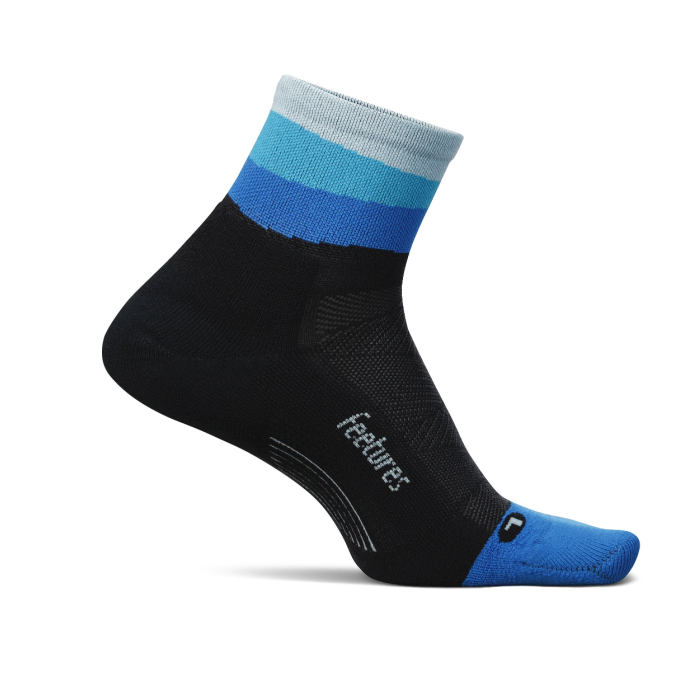
Feetures Elite Ultralight Quarter
Best Socks for Aerobic Activity in Warm Conditions
CleverHiker Rating: 4.3/5.0
Price: $18
Fabric: 92% nylon, 8% spandex
Height: Quarter
Cushioning: Light
Pros
- Affordable
- Lifetime warranty
- Comfortable
- Moisture-wicking
- Breathable
- Don't slide down
- Smooth-feeling fabric
Cons
- Hold odor more than others
- Lack long-term durability
The Feetures’ Elite Light Cushion Quarter socks are one of our all-time favorites for summer adventures in trail runners and hiking shoes where breathability and a tight fit are top priorities.
The Elite Lights are thin, stretchy, and fit snugly thanks to substantial compression around the center of the foot and at the ankles. Even after dozens of trail miles, we’ve found they stay smooth and wrinkle-free during activity.
The Elite Lights offer a bit of extra cushioning at the heel and toes. This padding in high-use areas makes them an excellent choice for hikes of any distance.
Like most thin socks, the Elite Lights won’t last as long as thicker, more durable options. We also find they fall a bit short when it comes to smell: the synthetic fabric holds onto stink a bit more than natural options like merino, so you may want to hang these to dry outside your tent.
However, when wicking socks are critical, the Elite Lights stand out for lightweight and rockstar breathability. Plus, they come in fun colors to match any style.
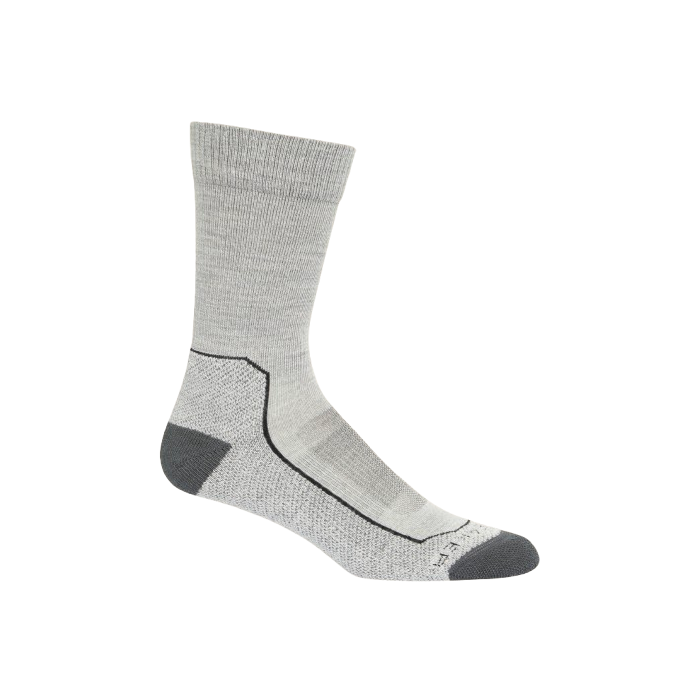
Icebreaker Merino Hike+ Light Crew
Best Socks for Wet Conditions
CleverHiker Rating: 4.2/5.0
Price: $23
Fabric: 61% merino wool, 37% nylon, 2% lycra
Height: Crew
Cushioning: Light
Pros
- Superb temp control in variable conditions
- Wicks well
- Comfortable feel
- Good odor control
- Reinforced in high-wear areas
Cons
- Loses shape throughout the day
- Susceptible to holes
The Icebreaker Merino Hike+ Light Crew socks offer decent comfort and performance. With thoughtful anatomical design, this pair hugs your feet in all the right places. The strategic cushioning and seamless toe construction make them blister-resistant.
The Merino wool blend really shines in wet weather. Even when we soaked them at water crossings, these socks kept insulating and remained comfortable rather than turning into cold, clammy foot prisons. The breathability is excellent, managing sweat well during active hiking.
Though these socks are not as bombproof durable as some competitors, the premium comfort and performance generally justify the price point.
These are fantastic all-rounders that excel in varied conditions. They’re particularly great for hikers who prioritize comfort and natural materials. Just maybe grab a couple of pairs if you’re planning an extended trek.
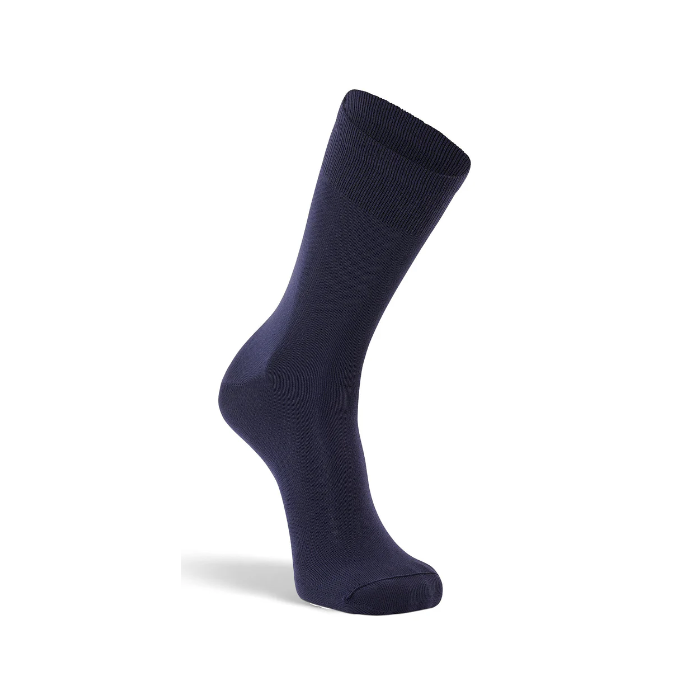
Fox River Wick Dry Alturas Liner
Best Sock Liner for Hiking
CleverHiker Rating: 4.2/5.0
Price: $11
Fabric: 93% polypropylene, 6% nylon, 1% spandex
Height: Calf
Cushioning: Light
Pros
- Affordable
- Cooling fabric blend
- Tight fit
- Comfortable
- Ultralight
- Effectively wick moisture
- Very low profile & excellent for layering
Cons
- Not durable – general con of sock liners
- A bit cumbersome to get on & off
Quality sock liners are few and far between, so we’re big fans of the Fox River Wick Dry Alturas Liner. If you’re looking for the perfect liners to rock beneath a thick wool sock on a long, chilly backpacking trip – or just an extra bit of blister protection on a summer weekend in the backcountry – these are the ones for you.
The Alturas stand out as performance liners that do exactly what we want: they stay up all day and easily wick sweat. Using an ultra-cooling polypropylene blend, the Alturas are exceptionally airy and comfy. They efficiently pull moisture away from the skin, making them the perfect layer beneath everything from lightweight socks with trail runners to heavyweight socks with leather boots.
The Alturas Liners aren’t as durable as most socks – an issue with sock liners in general. But they aren’t meant to last forever: liners are best used as a layer beneath your “normal” socks to help prevent rubbing, blisters, and hot spots on your toes and feet over long miles.
If you’re looking for low-profile, comfortable, and sweat-wicking liners for your next backcountry trip, you’ll be hard-pressed to find a better deal than these.
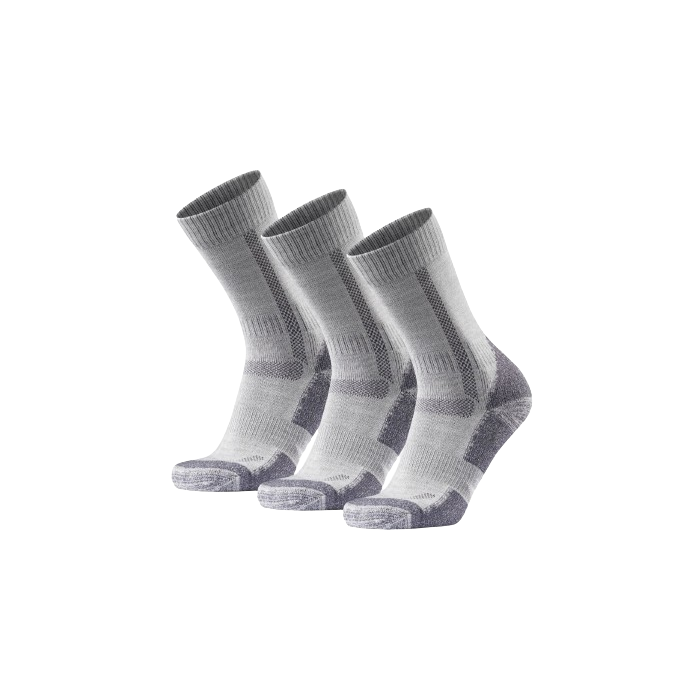
Danish Endurance Unisex Merino 3-Pack
Budget-Friendly Merino Hiking Socks
CleverHiker Rating: 4.1/5.0
Price: $34
Fabric: 38% merino wool, 30% acrylic, 30% polyamide, 2% elastane
Height: Calf
Cushioning: Medium
Pros
- Excellent value
- Affordable price per pair
- Versatile for town or trail
- Breathable
- Comfortable cushioning
- Good stretch
- Soft fabric blend
Cons
- Not as warm as others on this list
- Less durable than higher-quality options
- Dry very slowly
- Pills
The Danish Endurance Unisex Merino 3-Pack are the best bang for your buck when it comes to merino wool socks. If you’re looking for budget-friendly socks tough enough to tackle long miles of backcountry hiking – or just walking the dog to the brewery on a July afternoon – these socks are up to the task.
The Unisex Merinos come in a set of three, but the price per pair makes them an outstanding value. These Danish Endurance models are a blend of merino with synthetic fibers, which we find breathable, comfortable, and soft. These socks aren’t only easy on your wallet – they’re stylish, too, with a variety of colorways and cushioned pads on the top, toes, and heel.
The Unisex Merinos aren’t the most durable or warm socks on our list. And, due to their synthetic fibers, they soak up more water (and dry much slower) than all-merino options. However, at this price point, we are very impressed with their performance for high-heart rate activities like short to medium length backpacking trips, day hikes with lots of miles, and daily use through spring, summer, and fall.
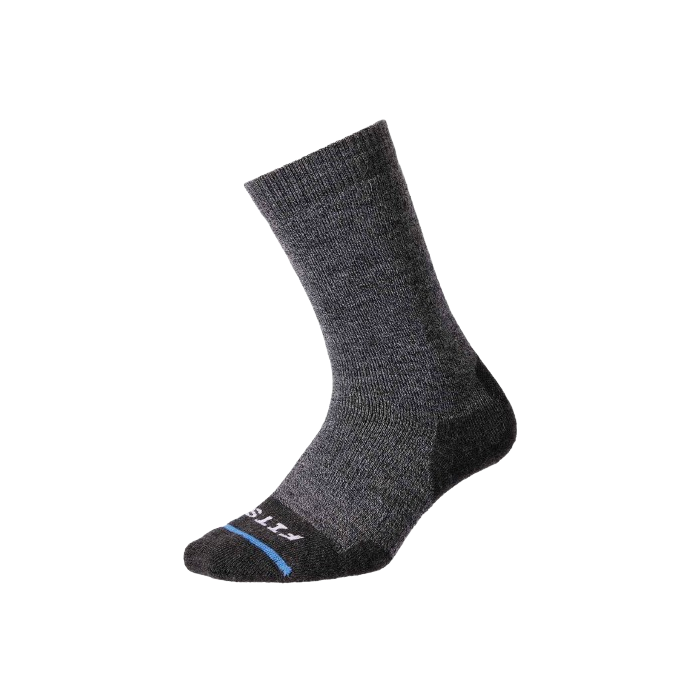
FITS Socks Medium Crew
Ergonomic Hiking Socks
CleverHiker Rating: 4.0/5.0
Price: $27
Fabric: 70% merino wool, 22% nylon, 6% polyester, 2% lycra
Height: Crew
Cushioning: Medium
Pros
- Soft
- Good amount of stretch
- Solid long-term durability
- Deep heel pocket for ergonomic fit
Cons
- Expensive
- Inconsistent sizing
- Not as breathable as some
The FITS Medium Crew hiking socks live up to their name with an impressively dialed-in fit that genuinely prevents slipping and bunching. The merino blend balances cushioning and bulk, while the anatomical design— especially the roomy toe box and deep heel pocket—delivers all-day comfort that holds up to long trail miles.
These socks really shine in their attention to detail. The graduated compression keeps blood flowing without feeling constrictive, and the reinforced high-wear areas show thoughtful durability design. Temperature regulation also performs admirably, keeping feet comfy across varying conditions, while moisture management helps ward off blisters.
However, they’re definitely an investment with a premium price tag. The medium cushioning might feel a bit much in already-snug hiking boots, and like most Merino socks, they’re not the quickest to dry when thoroughly soaked.
If you’re serious about hiking and appreciate superior fit and comfort, these are worth the splurge. The anatomical design and performance features make them particularly great for blister-prone hikers or those who’ve struggled to find socks that truly stay put.
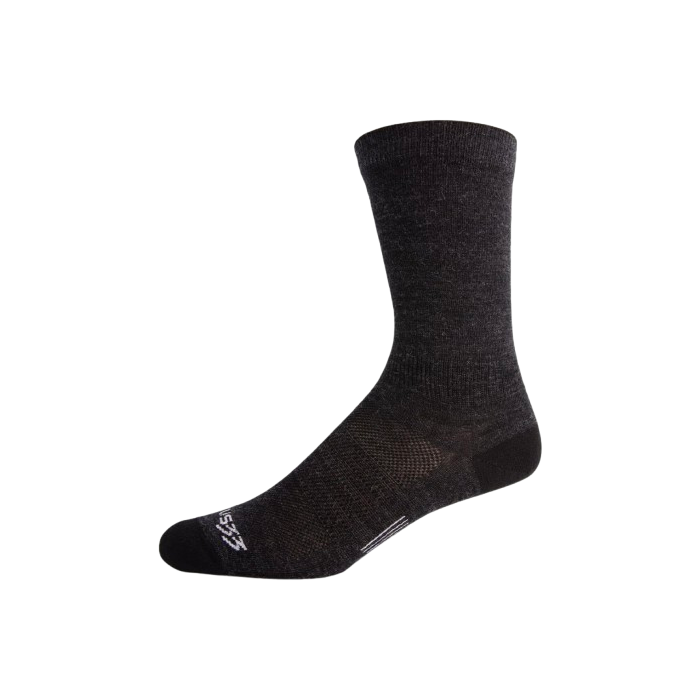
Minus33 Mountain Heritage Micro Liner
Solid Hiking Sock Liners You can Wear on Their Own
CleverHiker Rating: 4.0/5.0
Price: $19
Fabric: 68% recycled polyester, 24% nylon, 8% lycra
Height: Crew
Cushioning: Light
Pros
- Excellent fit
- Durable in high-wear zones
- Work well without additional socks
- Less expensive
Cons
- Inconsistent sizing
- Warm for mild temperatures
The Minus33 Mountain Heritage Micro Liner is a versatile liner sock packing an impressive Merino wool content into a surprisingly thin package. These 10-inch socks work equally well solo or as part of a layering system, making them adaptable for various conditions and activities.
The micro-weight construction nails it for boot fit—thin enough to layer without bunching but substantial enough to provide some cushioning on their own. The high Merino content delivers good temperature regulation and odor resistance, while the nylon blend adds necessary durability for a sock this thin.
However, the 10-inch height can feel a bit awkward with certain boot heights, occasionally sliding down during intense activity. These socks are a great choice for fine-tuning your sock system or adding a thin Merino option for moderate conditions.
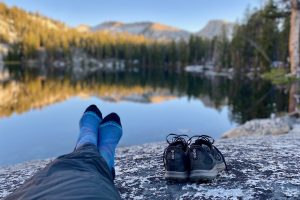
Product Comparison Table
| oSort | Product | Price | Fabric | Height | Cushioning | Comfort | Breathability | Warmth | Durability | 0 |
Darn Tough Light Hiker Micro Crew View Men's View Women's |
$25 | 54% nylon, 43% merino wool, 3% Lycra spandex | Crew | Light | 5.0 | 4.8 | 4.4 | 4.9 | 1 |
Darn Tough Hiker Full Cushion View Men's View Women's |
$30 | 69% merino wool, 27% Nylon, 4% Lycra Spandex | Calf | Full | 5.0 | 4.4 | 4.6 | 5.0 | 2 |
Smartwool Performance Hike Light View Men's View Women's |
$25 | 56% merino wool, 41% nylon, 3% elastane | Crew | Light | 4.9 | 4.4 | 4.4 | 4.6 | 3 |
REI Merino Hiking Crew View at REI |
$19 | 79% merino wool, 20% nylon, 1% Lycra spandex | Crew | Light | 4.9 | 5.0 | 4.3 | 4.4 | 4 |
WrightSock Double Layer Silver Escape Crew View at REI View at Amazon |
$27 | 68% Recycled Polyester, 24% Nylon, 8% Lycra | Crew | Light | 4.8 | 4.8 | 4.8 | 3.9 | 5 |
Darn Tough Mountaineering Socks View Men's View Women's |
$35 | 72% merino wool, 26% nylon, 2% spandex | Knee | Full | 4.8 | 3.9 | 5.0 | 5.0 | 6 |
Smartwool Hike Classic Edition Full Cushion Second Cut Crew View at REI View at Smartwool |
$23 | 33% merino wool, 33% other fiber, 24% recycled nylon, 9% nylon, 1% elastane | Crew | Heavy | 4.7 | 4.6 | 4.6 | 4.4 | 7 |
Balega Hidden Comfort View at REI View at Amazon |
$16 | 100% polyester | No Show | Medium | 4.8 | 4.9 | 4.0 | 3.9 | 8 |
Swiftwick Pursuit Quarter Crew High View at Amazon View at Swiftwick |
$20 | 62% merino wool, 35% nylon, 3% Spandex | Crew | Light | 4.7 | 4.9 | 4.5 | 4.8 | 9 |
WrightSock Coolmesh II View at REI View at Amazon |
$17 | 70% Dri-Wright II polyester, 26% nylon, 4% lycra | Ankle | Light | 4.5 | 4.8 | 4.1 | 4.5 | 10 |
REI COOLMAX EcoMade Lightweight Hiking Quarter Socks View at REI |
$16 | 77% recycled polyester, 22% nylon, 1% spandex | Ankle | Light | 4.4 | 5.0 | 4.2 | 4.5 | 11 |
Swiftwick Flite XT Trail View at Amazon View at Swiftwick |
$27 | 38% nylon, 24% merino wool, 22% olefin, 13% polyester, 3% spandex | Crew | Medium | 4.8 | 4.1 | 4.3 | 4.7 | 12 |
Sockwell Circulator Compression View Men's View Women's |
$33 | 32% merino wool, 32% stretch nylon, 31% rayon from bamboo, 5% spandex | Knee | Light | 4.6 | 4.6 | 4.4 | 4.2 | 13 |
Smartwool Classic Mountaineer Maximum Cushion Crew View at REI View at Smartwool |
$27 | 74% merino wool, 17% recycled nylon, 8% nylon, 1% elastane | Crew | Heavy | 4.9 | 4.4 | 4.4 | 4.6 | 14 |
Minus33 Mountain Heritage Full Cushion Crew View at Amazon |
$19 | 60% merino wool, 25% nylon, 14% stretch nylon, 1% spandex | Crew | Full | 4.8 | 4.0 | 4.7 | 4.7 | 15 |
Farm to Feet Damascus View at Amazon |
$22 | 51% merino wool, 45% nylon, 4% Lycra spandex | Quarter | Light | 4.4 | 4.7 | 4.4 | 4.7 | 16 |
REI Merino Wool Expedition Crew View at REI |
$23 | 79% merino wool, 20% nylon, 1% lycra spandex | Crew | Heavy | 4.6 | 3.9 | 4.8 | 4.5 | 17 |
Injinji Trail Midweight Mini Crew View Men's View Women's |
$16 | 58% nylon, 39% CoolMax polyester, 3% lycra spandex | Ankle | Medium | 4.5 | 4.4 | 4.2 | 4.1 | 18 |
Feetures Elite Ultralight Quarter View at Amazon View at Feetures |
$18 | 92% nylon, 8% spandex | Quarter | Light | 4.3 | 4.9 | 4.0 | 4.1 | 19 |
Icebreaker Merino Hike+ Light Crew View at Amazon View at Icebreaker |
$23 | 61% merino wool, 37% nylon, 2% lycra | Crew | Light | 4.4 | 4.7 | 4.3 | 4.3 |
|---|
How We Test & Methodology
We assess each pair of socks based on four criteria: comfort, warmth, breathability and dry time, and durability. Our team spent 100 days in every pair of socks across different terrains and conditions, from the hottest and driest to the coldest and wettest to find the top performers.
COMFORT
We evaluate socks for comfort while we’re hiking, trail running, and beyond, wearing them during downpours and sizzling hot summer days to understand how they feel during extended wear. When we’re evaluating hiking socks for comfort, we first look at the material composition – merino wool blends, for example, offer stellar moisture-wicking properties, temperature regulation, and natural softness.
Cushioning is another vital piece, so we prioritize socks with strategically placed padding in areas like the heel and ball of the foot to provide support and reduce impact mile after mile. Comfort is also dependent on fit since a well-fitted sock prevents blisters and hotspots by minimizing friction and staying in place. The top socks in this category also use seamless construction and prioritize a snug arch that supports the foot and conforms well to your foot’s shape to prevent irritation.
WARMTH
We assess warmth by taking these socks for a spin in wet, cool, and frigid temps and sleeping in them on cold nights. By monitoring our comfort level and toe circulation, we determined their effectiveness in keeping feet warm in chilly environments, especially during breaks or rest periods on the trail.
We look at the material composition, with natural fibers like merino wool, alpaca wool, and silk generally excelling for temperature regulation, odor resistance, and warmth. The top performers for warmth are typically a blend of synthetic and natural fibers. We consider the thickness and density of the socks since heavier, more cushioned models provide better insulation against the cold.
The fit of the sock is important as well. A snug fit prevents cold air from entering and ensures that you’ll retain heat (so long as it’s not too tight). Moisture management is also essential – wet feet quickly become cold feet, so blends that wick sweat and keep feet dry are crucial. Additionally, features like reinforced toes and padded heels add extra layers of warmth where it’s needed most.
BREATHABILITY
We test breathability by wearing the socks during strenuous activities to gauge how effectively they allow air circulation and moisture-wicking. We look at whether the socks keep our feet dry and cool when hiking in challenging terrain. We also note how long it takes each pair to dry out once they have gotten soaked on the trail either via sweat, precipitation, or a water crossing. Timing the drying process allows us to gauge discomfort and blister potential during prolonged hikes.
We consider elements like mesh panels and strategic knit patterns to figure out their impact on airflow and ventilation around the foot. Socks with better ventilation allow for better air circulation, reducing the likelihood of moisture accumulation.
DURABILITY
We test for durability by hiking in socks for hundreds of miles over dozens of days on trail – whether backpacking, hiking, or running – to see how different models withstand friction and repeated use over time. We look at the material composition, with the best of the best made from high-quality fibers like merino wool, nylon, or polyester blends that make for strong, long-lasting socks. We also evaluate seams, prioritizing socks with strong, flat seams that are less prone to rubbing and wear. We also assess how resistant socks are to repeated wash and dry cycles, which can begin to break the socks down after multiple washes and cause pilling and shrinkage.
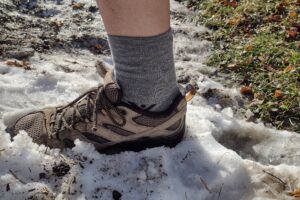
Why Trust CleverHiker
With over 1,000 days on trail and thousands of miles behind us, the CleverHiker team has trekked in all possible weather conditions to determine the best socks for hiking. Lead gear analyst Steve Johnson brings a dozen years’ experience from Colorado’s mountains to Lake Superior’s shores while evaluating a wide range of socks to identify the best ones for every use case. With a strong foundation in qualitative research and a deep understanding of outdoor gear, Steve’s rigorous standards guarantee that only the best socks make it onto our guide.
Joining him is Ian Krammer, with two decades of experience exploring Colorado’s most challenging routes and biggest mountains while evaluating a wide range of socks to identify the best ones for every use case. With a strong foundation in qualitative research and a deep understanding of outdoor gear, Ian’s rigorous standards guarantee that only the best socks make it onto our guide.
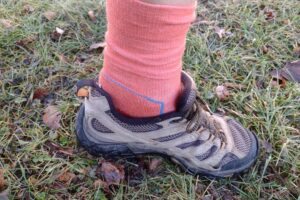
Analysis & Results
In this section, we put our best foot forward and discuss which socks score the highest when it comes to comfort, warmth, breathability and dry time, and durability.
VALUE
When we consider the value of a pair of socks, we’re looking beyond just their price. A quality pair of socks is an investment in durability, quality, and comfort that makes your time on the trail feel agile, fast, and pain-free.
The WrightSock Coolmesh II is not only one of the most affordable pairs on our list, but it’s one of our favorite minimal-cushion, high-value socks. Thanks to their double-layer design, the Coolmesh IIs effectively prevent blisters by minimizing friction. Built from moisture-wicking polyester and nylon, these socks will keep your feet dry and comfy on even the longest hikes. They offer excellent ventilation, a lightweight feel, and strategically placed padding that make them a practical choice for avid hikers seeking both performance and value.
The Swiftwick Flite XT Trails are also a great bang for your buck. We love them for their medium cushioning, and blend of synthetic fibers like nylon and spandex that deliver excellent durability and flexibility for tough routes. These socks are outstanding at managing moisture, wicking sweat away as you move, and maximizing airflow on hot days. Their targeted compression zones enhance blood circulation and reduce fatigue, and seamless toe construction prevents chafing and blisters, making them a great value pick.
We also highly recommend the Darn Tough Hiker Full Cushion socks. Sure, they’re a bit more expensive than the Coolmesh IIs or the Flit XTs, but these thick, warm, full cushion socks are made from the highest-quality merino wool that naturally wicks moisture and reduces odors. These socks offer plush comfort and impact absorption on rugged terrain. And, these fit exceptionally well because of the fine-gauge knitting that makes for a snug fit without slipping and bunching, reducing friction and hotspots. And, Darn Tough socks are backed by a lifetime warranty, making them an awesome investment for a lifetime of hiking.
COMFORT
Our top choices for comfortable, light-cushioned socks are the Darn Tough Light Hiker Micro Crew, REI Merino Hiking Crew, and Smartwool Performance Hike Light. All three pairs are merino wool blends that offer exceptional moisture-wicking properties and natural odor resistance – meaning when the weather is hot and your feet get sweaty, these socks will keep your feet happy. Each model features lightly cushioned soles and seamless toe closures to minimize friction and prevent blisters or rubbing during long treks. The Darn Tough Light Hiker Micro Crew is one of the most comfy pairs we tested due to the soft but strong reinforced heels and toes.
The Smartwool Performance Hike Light has a Merino blend that makes them super soft against the skin, while also wicking moisture and regulating temperature like a dream. Light cushioning adds a layer of comfort without sacrificing breathability, making them versatile enough for everything from quick morning hikes to multi-day adventures. We love their seamless fit and the way they keep feet feeling fresh, even after hours of wear.
The most comfortable full-cushioned socks in our guide are the Darn Tough Mountaineering Socks and Darn Tough Hiker Full Cushion. Since they’re built for hiking, snowshoeing, and skiing in extreme cold and harsh conditions, Darn Tough Mountaineering Socks are the cushiest socks we’ve tried. They have plenty of padding throughout, maximizing warmth and protection throughout. They’re also some of the tallest socks we tried, cutting off just below the knee, to keep your ankles, calves, and lower legs warm. The Darn Tough Hiker Full Cushion socks also offer substantial padding but are much lighter weight, not as tall, and less bulky, making them more versatile for different conditions while staying super comfy.
The Balega Hidden Comfort socks are another standout. Their plush underfoot cushioning is perfect for hikers who prioritize softness and support. Despite the luxurious feel, these socks manage to stay lightweight and breathable, making them great for shorter hikes or hot weather. They also have a snug fit that stays in place and eliminates that pesky mid-hike bunching or slipping.
WARMTH
When you need heavy-duty warmth for extreme conditions, the Darn Tough Mountaineering socks step up to the plate. Designed for high-mountain and cold-weather hikes, these socks are built with thick Merino wool for maximum insulation. They provide full cushioning that wraps your feet in comfort while offering exceptional durability to withstand tough terrain. Like all Darn Tough socks, they’re guaranteed for life, making them a solid investment for winter hikers. These socks also have exceptional moisture-wicking capabilities, ensuring your feet stay dry and blister-free.
For cold-weather adventures, the REI Merino Wool Expedition Crew socks are a top-notch option. Infused with a generous amount of Merino wool, these socks face off well against freezing temps. The thick, cushioned design offers added comfort and support, making them ideal for long hikes or backpacking trips in the winter. These socks are also great at managing moisture, so your feet stay warm and dry, and REI’s quality and eco-conscious materials make these a great choice for those who want warmth without sacrificing sustainability.
Also in the mix of top picks, the Minus33 Mountain Heritage Full Cushion socks are a fantastic choice for warmth. Made from high-quality Merino wool, you can count on excellent thermal regulation and softness. The full cushioning adds an extra layer of insulation to keep your feet toasty on frosty mornings or snowy trails. They’re also designed to reduce friction and blisters, so you can focus on enjoying the hike instead of worrying about your feet. We appreciated the reinforced heel and toe for added durability in high-impact areas.
The Darn Tough Hiker Full Cushion are also noteworthy. They’re less padded and less insulated than mountaineering options, but strike a better balance between warmth and versatility, with full cushioning that provides significant insulation without the size, weight, and height of mountaineering socks, making them suitable for a wider range of hiking conditions. They are a stellar choice when the temperatures swing from freezing to 70°F.
BREATHABILITY & DRY TIME
Thinner socks with performance designs are the most breathable and fastest-drying socks for hiking. The top half of the rankings include the Darn Tough Light Hiker Micro Crew, Feetures Elite, Farm to Feet Damascus, and Sockwell Circulator. Each model prioritizes breathability and quick drying times thanks to high-quality materials and innovative design features. They use blends of natural and synthetic fibers to make for very effective moisture management – and rapid evaporation – that will keep your feet dry and comfortable, whether you’re hiking through the hottest part of the day and your feet are sweating, or you accidentally step in the water during a creek crossing. Each of these socks includes features like seamless construction and targeted ventilation zones to enhance airflow and reduce moisture buildup.
Darn Tough and Farm to Feet utilize natural merino wool combined with synthetic fibers to promote excellent moisture wicking. The Feetures Elite and Sockwell Circulator use advanced synthetic blends for tailored fit and unrivaled breathability. And, the Smartwool Performance Hike Light offers lightweight construction and targeted mesh zones for maximum airflow. If your top priority is a short dry time and plenty of ventilation, all of these models will keep your feet cool, dry, and comfortable on the trail.
The WrightSock Coolmesh II socks are specifically designed for ultimate breathability, featuring a double-layer construction that wicks moisture effectively and allows air to circulate around your feet. The outer layer pulls sweat away from the inner layer, which rests snugly against your skin, creating a system that keeps your feet dry and comfortable. These socks are lightweight and thin, making them a great option for hot-weather hiking or high-intensity activities. Thanks to their fast-drying materials, they’re also a solid pick for multi-day trips where quick drying is essential after washing.
Rounding out our picks, the Swiftwick Pursuit Four excels in both breathability and dry time, blending Merino wool with synthetic fibers for maximum performance. The material actively pulls moisture away from your feet and disperses it, allowing the socks to dry quickly, even after creek crossings or rainy hikes. They also feature vented panels that promote airflow for all-day cool and comfy feet. Despite being lightweight and breathable, they still provide a snug, secure fit that helps prevent blisters.
DURABILITY
Earning a top score, you won’t find more durable socks than the Darn Tough Mountaineering Socks. Lead Gear Analyst, Ian Krammer, has been using the same three pairs for the third season in a row, and they are still going strong. These socks are made from a very high-density knit that guarantees longevity, even after dozens of wear and wash cycles. The merino wool, combined with nylon and spandex, provides impressive strength and flexibility to help prevent tears and thin spots and maintain their shape over time. With heavily reinforced high-wear areas in the heel and toe, the Mountaineering Socks can endure rigorous use in extreme environments.
The Darn Tough Hiker Full Cushion socks are legendary for their durability. Made with a high-density Merino wool blend, these socks are designed to withstand heavy use without thinning, tearing, or losing their shape. After hundreds of tough trail miles, these socks never let us down. The full cushioning provides extra comfort while also adding to the sock’s resilience.
Though they are not nearly as burly as regular hiking socks (because they aren’t meant to be) the Feetures Elite exceeded expectations. Thin, sports-focused socks aren’t always the most durable, but this ankle-height model is the exception. They use a blend of synthetic fibers that make them strong and resilient. The snug fit reduces friction and wear, and the seamless toe and targeted compression zones help them last for years by minimizing the risk of fabric breakdown over time.
We highly recommend the Farm to Feet Damascus for their excellent durability as well. Using a nearly 50 / 50 blend of merino wool and nylon, these socks are extra strong but still stretchy and snug. Their reinforced high-impact zones withstand the rigors of hiking and backpacking, and they hold up incredibly well after countless wash cycles.
The Swiftwick Flite XT Trail socks are built to handle demanding trails and rugged conditions. With a mix of high-performance synthetic materials, these socks offer outstanding abrasion resistance and maintain their integrity. Reinforced zones in high-wear areas like the heel and toe ensure they stand up to heavy use. The addition of grippy fibers in the sole helps keep your feet secure in your boots, reducing wear from sliding or bunching. Despite their toughness, these socks remain lightweight and breathable, making them a great choice for long days on challenging terrain.
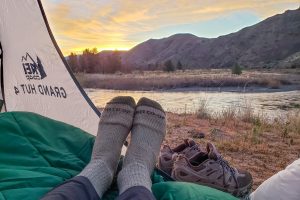
How to Choose Hiking Socks
CUSHIONING
Cushioning affects durability, comfort, and warmth. Light cushion socks are best for running or hiking in low-cut shoes. We typically prefer them because they dry quickly and breathe well, but they’re not as durable as other socks.
Socks with light cushioning are relatively thin and have a good balance of breathability, moisture-wicking, comfort, and durability.
Medium cushion socks are good for hiking in average to cold weather. They can be well-padded in the heel and ball of the foot to protect your feet from impact.
Socks with heavy cushioning are the thickest and warmest. Many hikers find them too bulky and hot for backpacking, but they’re great for warmth at camp, or while winter hiking, and mountaineering.
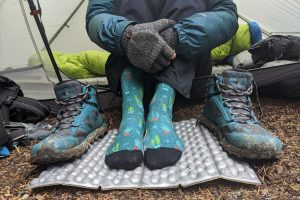
MATERIAL
Socks made with polyester, nylon, and other synthetic fabrics are breathable, moisture-wicking, and quick-drying, so they’re great for hiking. They also tend to be a bit more durable than natural fibers, though they can pill and hold onto odors more.
Wool is a natural odor-resistant fiber that’s excellent for managing moisture, controlling odor, and keeping you warm when wet. Merino wool is the cream of the crop, a natural fiber from Merino sheep known for its warmth, softness, and moisture-wicking properties. It’s used often in socks because it works exceptionally well blended with synthetic fibers like nylon and polyester that make it even more durable, stretchy, and comfy.
Cotton collects and holds moisture, which can lead to blisters (check out our How to Prevent and Treat Blisters post for more info). We don’t recommend socks with any cotton content for hiking – but they’re inexpensive and comfortable for everyday use.
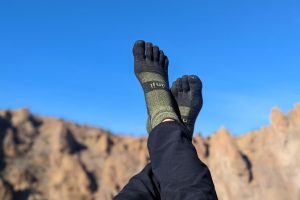
HEIGHT
Sock height comes down to personal preference, which is why most of the socks on this list come in a variety of heights. No-show and quarter socks come to the ankle and are most compatible with trail runners or low-cut hiking shoes. They’re stylish when wearing shorts and offer the best airflow. But, they leave your ankle exposed to heel clipping, can easily collect debris, and they need to be pulled up periodically.
Crew socks come up to about mid-calf and work well with almost all footwear, including boots. They tend to stay up and keep debris out better, as well as offer some protection to your ankles. Knee socks and crew socks will feel warmer and are easier to overheat in, but you’re guaranteed a cool sock tan if you wear them all summer.
SOCK LINERS
Sock liners are ultralight, ultra-thin socks often worn underneath thicker hiking socks to prevent blisters and add a bit of comfort. They effectively reduce friction by hugging your foot and providing a smooth surface for socks to glide across. In hot weather, they can help manage moisture by wicking sweat and preventing blisters. In cool weather, sock liners add a bit of comfort and warmth.
That said, none of the CleverHiker team uses sock liners. Sock liners are a bit of an “old school” move: they were the best way to prevent blisters using classic, heavy leather boots that were popular from the 70s until the 00s. Blisters were common with heavy footwear that was slow to break in, and sock liners were a great solution to reduce friction.
However, most modern hikers – from novice day hikers to seasoned thru-hikers – tend to hike exclusively in lightweight trail runners paired with breathable socks. That means issues with blisters are dramatically reduced. But, when blisters do become an issue, we stop and treat individual hot spots with tape, lube, or bandage. A sock liner is still a great choice if you’re logging serious miles and want to prevent blisters, need a bit of extra cushion, or are breaking in new footwear and want a bit more protection.
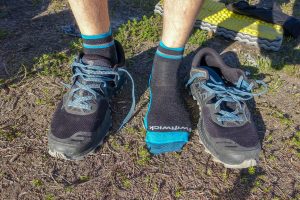
SUPPORT
Some socks are designed with strategically placed bands of compression around the calf, ankle, or arch of the foot to help socks stay in place and prevent them from twisting and bunching. Compression also provides support to muscles and ligaments to alleviate pressure, increase blood flow, and even prevent conditions like plantar fasciitis, which can make hiking extremely painful. If you have an existing condition, a good pair of socks can work just as well as an Ace wrap or sports tape, and can help increase your distance, endurance, and overall performance on trail.
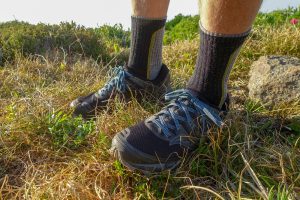
FIT
Your socks should fit just right. Not too tight, but not too loose. We recommend trying at least a few sizes of new socks whenever possible to account for differences in stretch, stitching, and sizing that vary from brand to brand and year to year. Be sure to try your new hiking socks on with the specific pair of hiking boots or shoes you plan to wear on trail, and account for wiggle room and comfort.
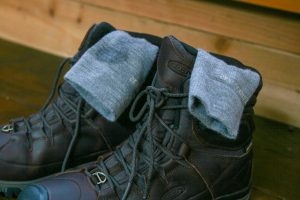
SIZING
Light compression and a snug fit aid in your socks ability to effectively wick moisture, breathe, and stay wrinkle-free. Conversely, socks that are too tight can restrict blood flow and limit your toes’ range of movement. While this mostly comes down to personal preference, we recommend choosing socks that fit a bit tighter than a bit too big to prevent hotspots or blisters.
WASHING & DRYING
The key when it comes to washing your hiking socks: keep the temperature low – or air dry them. While socks made of nylon and polyester can handle the heat, pairs with high merino wool content are likely to shrink in a hot dryer. For best results, follow the manufacturer’s instructions for washing and drying your socks to maintain their cushion and avoid miniaturizing them.
We recommend washing wool products inside-out on a cool or lukewarm washing machine setting with gentle detergent, then air drying them on a clothesline or flat surface. If you’re in a hurry, the next best thing is to tumble dry your wool socks on low. If you treat them with a bit of care and patience, your hiking socks should last for a long time.
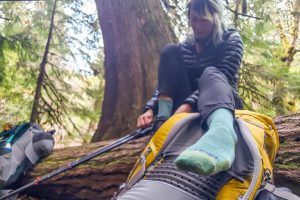
HOW TO AVOID LOSING SOCKS
It’s a huge bummer to have a pile of single expensive hiking socks, but we all know how easy it is to lose track of them. Consider using an inexpensive small mesh laundry bag as your sock-specific hamper and just toss the laundry bag into the wash when it’s full. Soapy water will get through the bag and the socks will get clean, but they won’t go missing.
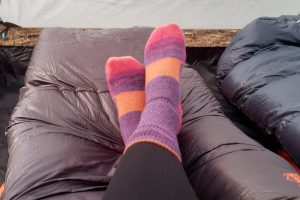
Conclusion
We hope this guide helps you find the best hiking socks for your needs. Choosing socks based on comfort, warmth, durability, and breathability will only make you feel more confident on your next hike. With the right socks, you can put your best foot forward on the trails.
